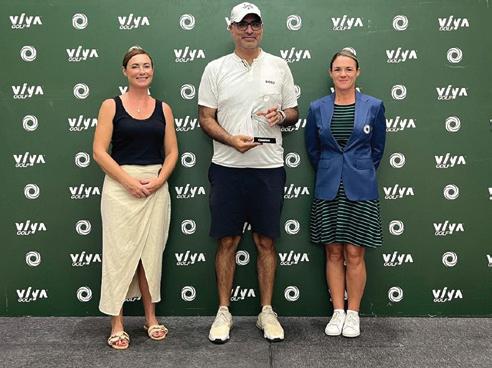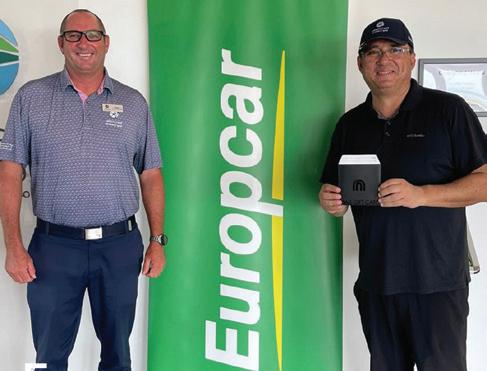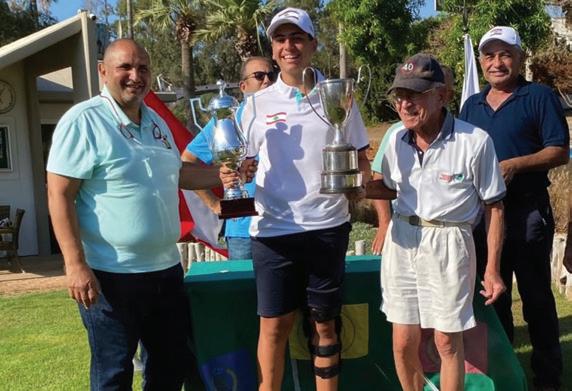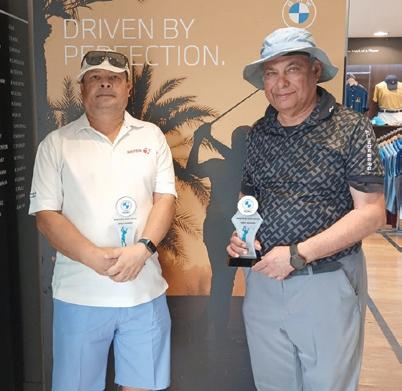














4 The Scottie Show World Number One is unstoppable, and he’s not even fazed by his form of golf. by harry grimshaw
starter
6 Enter The Centurion Championship golf in the heart of Hertfordshire. by harry grimshaw
42 Rhodes To Victory Mimi is gaining serious momentum on tour. with harry grimshaw
46 Inside The Cleeks Rebrand Jonas Mårtensson wants to change how you see golf. with harry grimshaw
16 Swing Analysis
How Gary Woodland got his speed back after brain surgery. by dave allen
18 Take The Draw? What the rules say about leaving a match early. by ron kaspriske.
20 Smooth Out
8 Journeys
Fatima Cano with keely levins
10 The Fringe
Blake Griffin by alex myers
12 Next One’s Good
How Pine Valley’s longtime super made good on an eighthgrade essay. by jerry
tarde
48 How To Not Become A Crazy Golf Parent by the editors
58 The End Of The Range How we’ve been practicing all wrong. by sam weinman
14 Fairway Bunker Master one of the toughest shots in golf. by jason birnbaum
Your Swing Patrick Cantlay explains how to improve the rhythm in your swing. by luke kerr-dineen by dave allen
21 Getting SlowPlayed? Here’s How To Cope You should use these three strategies when waiting to play your shot when caught with slow players. by lynn marriott and pia nilsson
Located in Bahrain’s oil hub, Awali Golf Club is made entirely of sand. It’s unconventional setup, remains a respected and historically significant venue in Gulf golf page 36.
22 Baby Drivers
This craze has been a trend for more than a decade in the making. by e. michael johnson
26 The Hidden Key To Getting On Greens
Here’s a hint: It ain’t distance by mike stachura
28 Your Questions Answered
Beware the potential pitfalls of purchasing ‘category’ golf clubs when getting started. by mike stachura, e. michael johnson and jonathan wall
30 eGolf Megastore welcomes Peter Millar The Middle East’s larget golf retailer, has joined forces with the luxury apparel. by harry grimshaw
32 All About Wedges Getting this right takes little effort but will save you shots. by e. michael johnson
34 What’s In My Bag Nick Taylor with dave allen
36 Awali Golf Club
Get to know the oldest desert golf course in the GCC. by harry grimshaw
40 Ask A Super
Should I leave bunker rakes inside or outside the sand? by drew powell
66 Club News
A gallery of just a handful of the local winners in the amateur circuit in the region.
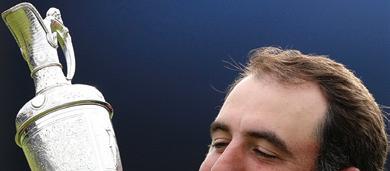
If you’ve been living under a rock, Scottie Scheffler is the best golfer in the world right now, and it’s not even close.
BY HARRY GRIMSHAW

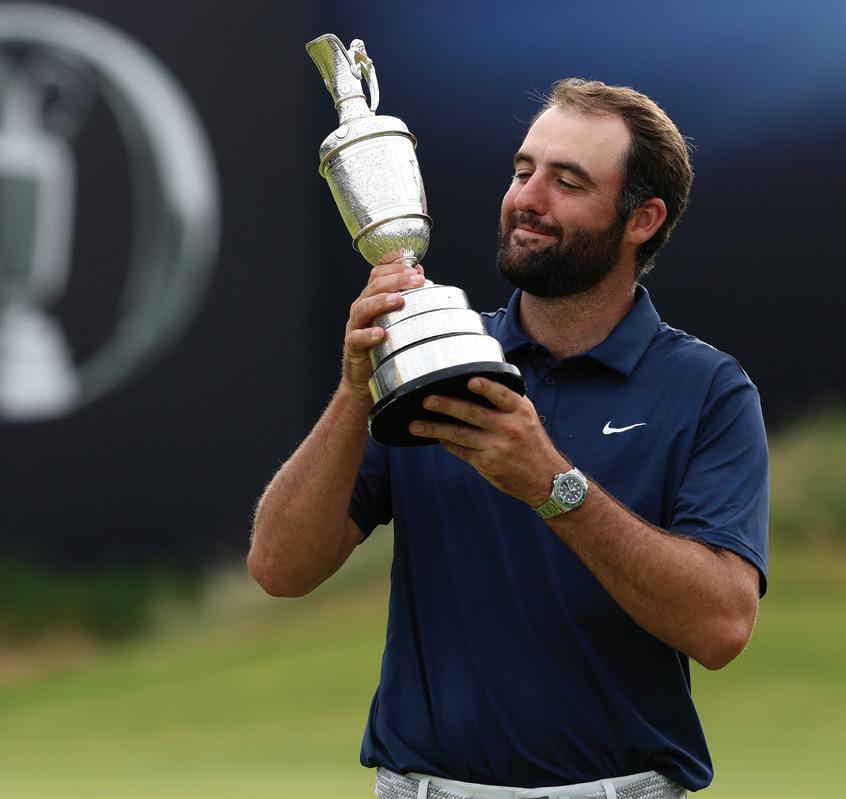
HE’S GOT A STEELY determination and looks like your average joe, but he plays better than anyone else.
I think it’s safe to say that Scottie has been dominating global golf in a way we haven’t seen since Tiger Woods. As of March 2022, he’s been ranked Number One in the world and has held that spot for over 150 weeks straight now. He’s won 22 times as a professional, the first coming just over seven years ago, and he has already won four times this season alone. Two of those titles this year have been major championships in the U.S. PGA Championship and the Open Championship, which now puts him two thirds of the way to the Career Grand Slam, that Rory McIlroy has only just ticked off ! It’s an absurd win rate in modern golf.
What makes Scottie so good? It’s his consistency, especially tee to green. He’s miles ahead in leading the PGA Tour in Strokes Gained, Tee-to-Green, Off-the-Tee and Approach to the Green. It basically means he hits a ton of fairways, his iron play is ridiculously precise, and he almost always puts himself in a strong position to hole his putt.
But that is something which wasn’t a strength, like it is now. Since switching to
a TaylorMade mallet putter and working with a new putting coach, Phil Kenyon in September 2023, his putting has gone from a slight liability to at least average, if not better. Since that started clicking, Scottie has become nearly unbeatable.
Is he comparable? In terms of comparisons, he doesn’t have Tiger’s flair or Rory’s power, but in terms of week-to-week performance and how few mistakes he makes, he’s probably the closest thing to peak Vijay Singh, except with even better ball striking.
So, the short answer is, Scottie’s not just good. He’s historically great right now. But the funny thing is, he doesn’t really even care about the trophies he wins which is the crazy part. That’s for another time!







harry.grimshaw@motivate.ae
@harrygrimshaw / @golfdigestme
editor-in-chief Obaid Humaid Al Tayer
managing partner & group editor
Ian Fairservice
chief commercial officer
Anthony Milne
editor Harry Grimshaw
art director Clarkwin Cruz
editorial assistant Londresa Flores
publisher David Burke
general manager - production
S. Sunil Kumar
production manager Binu Purandaran
assistant production manager
Venita Pinto
THE GOLF DIGEST PUBLICATIONS
editor-in-chief Jerry Tarde
senior director, business development & partnerships
Greg Chatzinoff
international editor Ju Kuang Tan
GOLF DIGEST USA
editor-in-chief Jerry Tarde
general manager Chris Reynolds
editorial director Max Adler
executive editor Peter Morrice
art director Bill Specht
managing editors Alan P. Pittman, Ryan Herrington
playing editors Collin Morikawa, Jordan Spieth, Bubba Watson
head office
Media One Tower, PO Box 2331, Dubai, UAE Tel: +971 4 427 3000; Fax: +971 4 428 2266
dubai media city
SD 2-94, 2nd Floor, Building 2, Dubai, UAE
Tel: +971 4 390 3550; Fax +971 4 390 4845
Email: motivate@motivate.ae
abu dhabi
14th Floor, Office 1406, Makeen Tower, 9th Street, Al Zahiyah, PO Box 43072, Abu Dhabi, UAE Tel: +971 2 677 2005; Fax: +971 2 657 3401
Email: motivate-adh@motivate.ae
saudi arabia
Regus Offices No. 455 - 456, 4th Floor, Hamad Tower, King Fahad Road, Al Olaya, Riyadh, KSA
Tel: +966 11 834 3595 / +966 11 834 3596
Email: motivate@motivate.ae
london
Motivate Publishing Ltd, Acre House, 11/15 William Road, London, NW1 3ER, UK
Email: motivateuk@motivate.ae
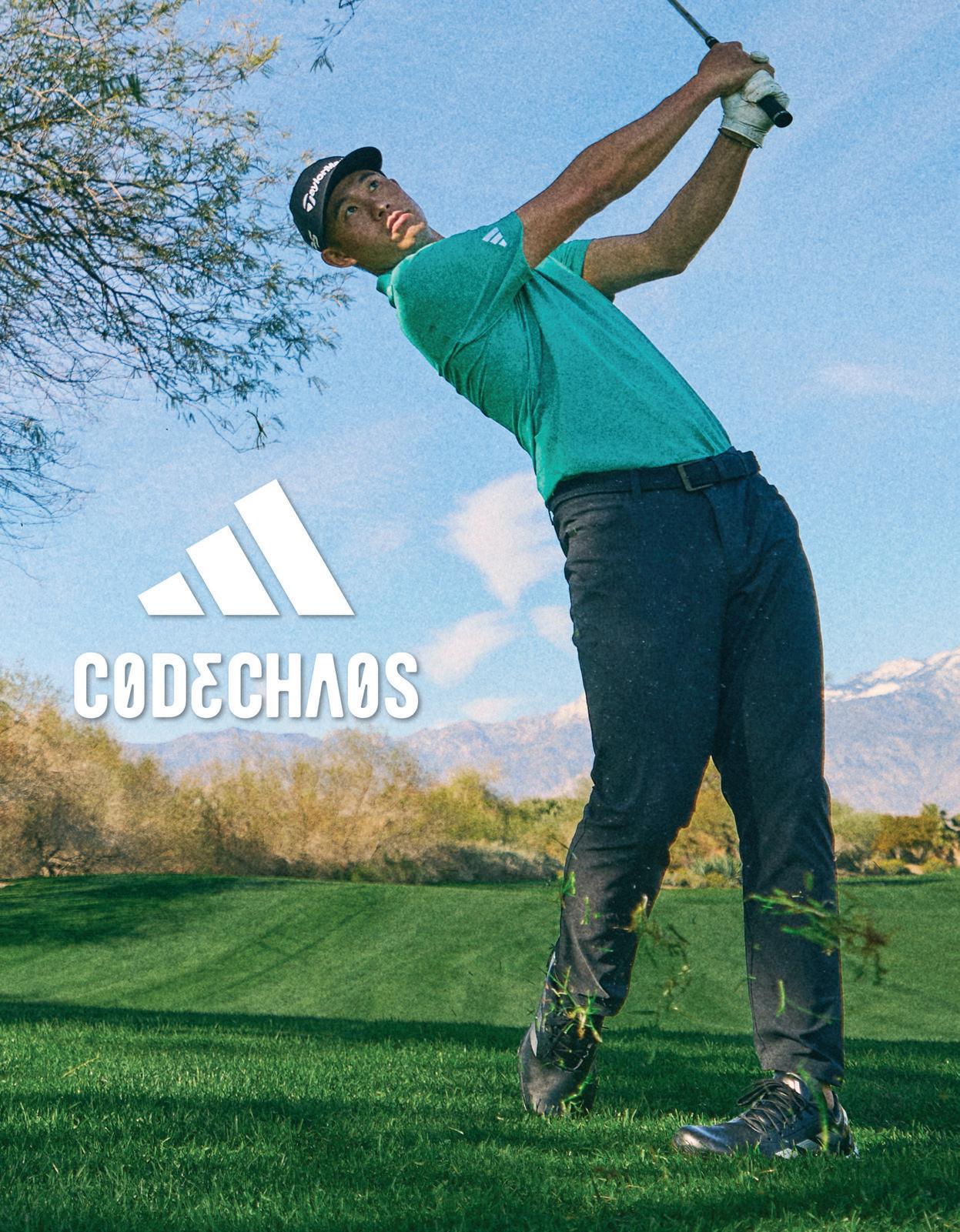


Championship golf in the heart of Hertfordshire


SET JUST WEST OF St Albans, UK, the Centurion Club offers a dramatic 18-hole course that blends mature pine woodland within a sculpted terrain.
Opened in 2013, the par-72 layout stretches to 7,100 yards and works effortlessly between natural and shaped landscapes. Tight, tree-lined fairways give way to sweeping views, deep bunkers, water hazards and undulating greens. It’s a true modern test built to challenge strategy as much as skill.
The club has hosted the DP World Tour, LIV Golf and now once again welcomes the Ladies European Tour for the PIF London Championship, part of the PIF Global Series.



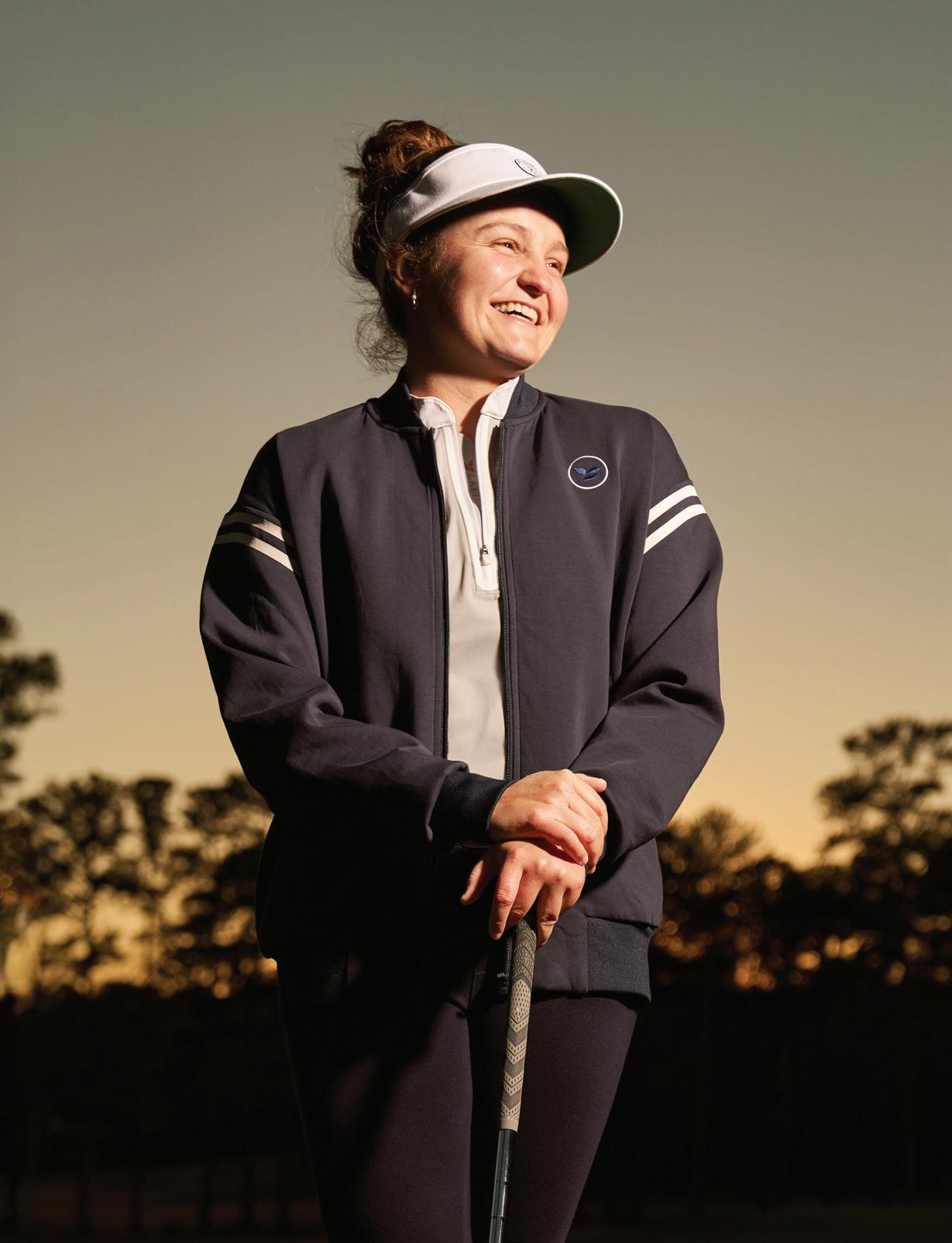
WITH KEELY LEVINS
Ithought I was go I ng crazy. It was 2022, and I started my first full season on the LPGA Tour playing the best golf of my life. Then suddenly, I couldn’t control the golf ball. I was hitting drives 50 yards off line. I felt a strange tingling sensation in my right forearm, but there was no apparent injury. I thought I’d have to quit the game.
Gr owing up in Santiago, Spain golf was not a popular sport, but my parents played and taught my brothers and me the game When I was a teenager, the course I played shut down. The only place I could practice was a range 20 minutes away. You must be 18 years old to get a car license in Spain, but only 16 to get a motorcycle license. I rode my motorcycle to the range with my clubs on my back to be able to practice.
● ● ●
FATIMA CANO
LPGA TOUR
AGE: 29
FROM: SANTIAGO, SPAIN
Th en my game disappeared. In San Diego at the JTBC Classic in 2022, I felt a tingling sensation in my forearm when I hit an iron shot I shanked it horribly. At the time, I didn’t think anything of it , but then the feeling returned again and again. I felt like I had no strength in my right hand. I was hitting drives 50 yards off line. I shot 80 multiple times.
● ● ●
I competed in regional tournaments and was improving, so I contacted an agency that helps place athletes in smaller American universities. They brought me an offer for a full ride to Troy University in Alabama. The pictures looked nice, and the idea of playing golf year-round sounded like the opportunity my game needed. I accepted the offer having never visited the campus.
●
●
●
I don’t know what my coaches were thinking. I hadn’t accomplished much to that point, but it worked out well for all of us. I won eight collegiate tournaments and turned pro after graduation. I continued to improve while playing on the Epson Tour, and in 2020 I won my first event . The next year I would’ve been on the LPGA Tour full-time, but the priority list was frozen due to COVID, so I played on Epson again in 2021. I played the best golf of my career in 2021 and was ready for my first LPGA season.
I went to physiotherapists, but they found no evidence of injury. I kept playing, but the tingling feeling continued. I missed cut after cut. I was terrified of what might happen every time I swung. During one tournament, I felt like I couldn’t breathe. I was so hot, and my chest felt so tight that I wanted to take my clothes off. I felt like I was dying. The paramedics said I was having a panic attack. I started to question myself: Was the feeling in my arm my fault, a byproduct of stress?
●
My game got worse. In Canada, I hit a wild shot into the kids’ play area— thankfully no one was there. At an Epson event, I lost so many balls that I had only one left on the 16th tee. I shot 89 and wasn’t allowed to play the next day. On Epson, you can’t continue if you shoot 88 or higher. I remember sitting on the floor where I was staying, talking to a friend, laughing and crying in disbelief.
● ● ●
I had my coach, Eric Williamson,
look at my swing. I was ready to rebuild it. Maybe that would fix me. He told me to go see another doctor before we dismantled my entire swing. I flew home to Spain and underwent a nerve conduction test and an MRI. Both were normal. I saw an orthopedist who gave me cortisone shots. I took three months off, but when I played again, the sensation was still there.
● ● ●
I came to terms with the fact that my career was over. Something was broken. I didn’t know if it was my brain, my body or my swing, but no one was able to fix it. My orthopedist urged me to see one more doctor. I didn’t want to, but I agreed, and the doctor knew what was wrong when I explained my symptoms. He’d seen it before. He did an ultrasound and knew where to look. I had pinched nerves in my forearm. Everything that had happened wasn’t my fault.
● ● ●
I had surgery to release the pinched nerves in October 2023. After a few weeks, I could chip and putt. At the end of November, I played my first 18-hole round. The sensation was gone. I felt like myself on the course again. Without fear holding me back, my game came back quickly. I had Epson starts left over from my medical leave and earned a pair of top-five finishes in July 2024. I won in September. In October, I was high enough on the money list to earn my LPGA card for the 2025 season.
● ● ●
It’s all happened so fast since I had the surgery; I can’t believe it’s real. This time, I’m going to enjoy myself on the LPGA Tour. Last time, I didn’t have fun because I was too worried about everything. Now I’m grateful to be playing golf again. Everything else is a bonus.
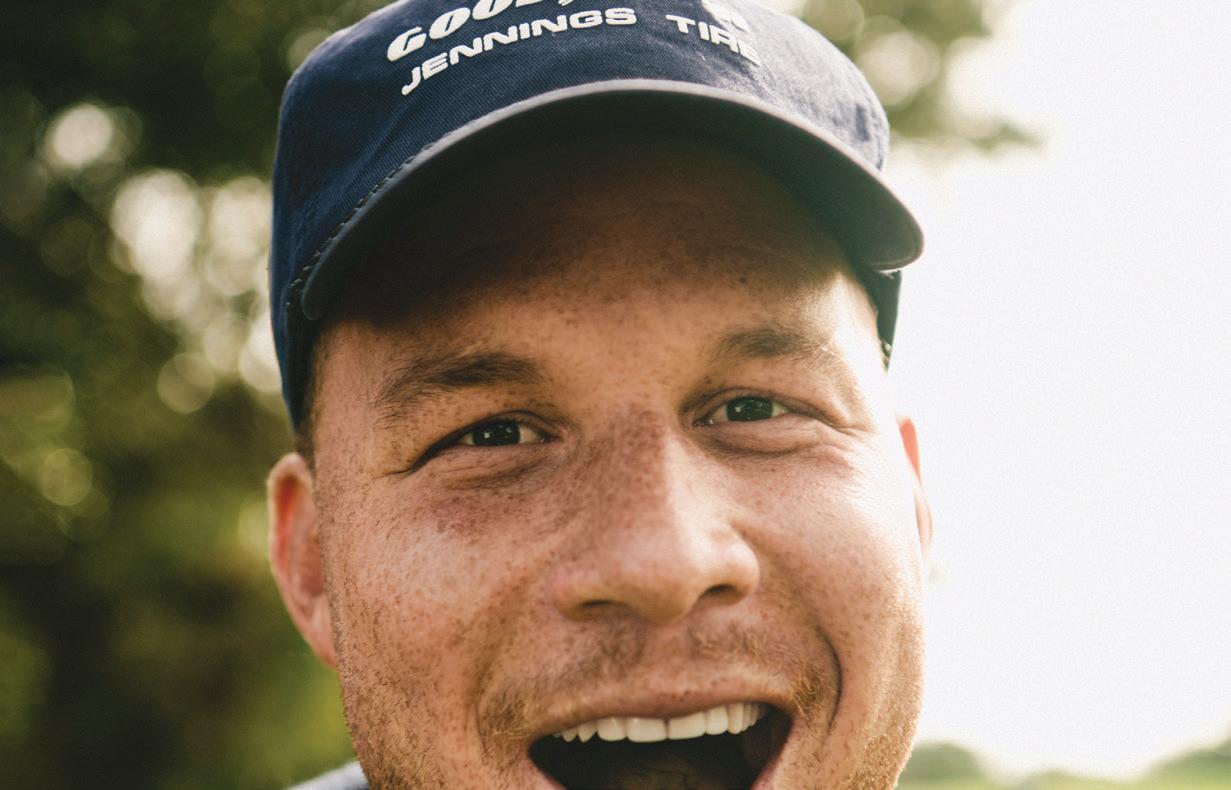
BY ALEX MYERS

Blake Griffin played his final NBA game in April of 2023 but didn’t take long to produce a different kind of athletic highlight a few months later at Brentwood Country Club. The six-time NBA All-Star used a 7-iron to make a hole-in-one on the 187yard second hole and started leading another fast break.
“I threw my club and took off running, and then my buddy’s like, ‘I haven’t hit yet,’ ” Griffin says. “I just ran back, and then, of course, I immediately blasted one out of bounds on the next hole.”
The experience was exhilarating, Griffin says, which is how basketball fans often felt after watching him play
throughout his decorated collegiate and pro career. The high-flying forward put more opponents on posters than possibly anyone in basketball history. Now he’s arguably prouder of the framed display of his ace hanging in his house. All the more impressive, the hole-in-one came in Griffin’s first few years of playing the game.
The COVID pandemic led to a welldocumented golf boom that may have hit NBA players more than any other cross-section of people. Many of those playing in the league’s Orlando “bubble” in 2020 picked up the game for the first time given that they didn’t have much else to do between games. Griffin’s Detroit Pistons were one of eight teams not invited to Orlando due to their poor record, but the experience wound up having a trickle-down effect, creating a “bigger contingency of golfers in the league” and influencing him to pick up the game the following year.
As he got into his 30s, Griffin realised he was eventually going to need to find something to replace basketball in his life. The former mayor of “Lob City”— the name given to his highlight-reel Los Angeles Clippers—turned to lob wedges for both fun and sport.
“It’s a good, competitive outlet for me,” says Griffin, who the Clippers selected with the No. 1 pick in the 2009 NBA draft after Griffin swept the national player-of-the-year awards as a sophomore at the University of Oklahoma. “ I always make these stupid mistakes, and then you learn from it, and you move on. That’s what I absolutely love about golf. It’s a mental battle between your ears.”
Griffin has whittled his handicap down to an 11 at Brentwood Country Club and Lakeside Golf Club in the Los Angeles area, getting help along the way with lessons first from Matt Parkovich at Urban Golf Performance and now Tanya Dergal at Brentwood. Not surprisingly, the 6-foot-9 Griffin has some serious pop off the tee, but unlike when he was throwing down ferocious dunks, he plays his best when he tries to take “70-percent” swings, especially with his driver. Griffin has also lowered his scores by treating 18-hole rounds like 48-minute basketball games and waiting to evaluate a performance until the final buzzer sounds.
“That’s the thing that I carry over,” says Griffin, whose career-best score (so far) is a 78 at Gozzer Ranch Golf & Lake Club. “It’s never as good as you think; it’s never as bad as you think. [It’s about] staying even and not trying to get outside of yourself.”
Griffin isn’t dunking on opponents on the court anymore, but he says he experienced a golf equivalent of that recently when he went one-on-four with his buddies during a game of Wolf—and made a 30-foot birdie putt to win the hole. “That was incredible,” Griffin says. “To take them all on, that was a pretty fun feeling.”
Like many athletes, Griffin knew he needed to find something active to fill his days in retirement. Unlike many players, however, he was able to walk away on his own terms. “It was time for me. My body was telling me, I think we’ve had enough,” Griffin says of retiring at 35. “I had a decent amount of injuries in my career and, thankfully, got to play with some awesome guys and
nect between NBA fans and the NBA organisations and maybe some players right now. I think celebrating how good these guys are and what they’re able to do and highlighting how hard it is to actually do this sport could be good for basketball.”
It’s a role that seems perfect for Griffin, who has long been entertaining fans with more than his incredible aerial performances like the time he jumped over a Kia car to win the 2011 NBA Slam Dunk Contest. Griffin’s hilarious deadpan delivery has made him a popular pitchman (his Red Lobster commercials are currently getting as much air as he used to get on the court) and even led to him hosting a reality TV show for a year and dabbling in stand-up comedy.
I asked him what shot he’d feel most comfortable hitting in front of a crowd. Griffin responded, “A one-foot putt would be great.”
have some great memories. I always said when that time came, I’m gonna try to retire as gracefully as possible. It’s been great, a whole new world has opened up: a lot more golf, a lot more time with family.”
NBA stars are playing longer these days—notably LeBron James and Griffin’s former Clippers teammate Chris Paul, who are still playing at 40—but Griffin has been happy to relinquish the day-to-day grind of professional basketball. “There’s some aspects of basketball I definitely miss, but, thankfully, I had a decently long career,” Griffin says before breaking into a smile, “and my body hurts a lot less.”
That doesn’t mean Griffin’s basketball career is over. Earlier this year he was named one of Amazon’s Prime Video studio analysts for when the streaming service starts its NBA coverage this upcoming season.
“I’m very excited,” Griffin says about his new gig. “ I think there’s a discon-
Griffin’s golf game—and humour— were on display in 2024’s The Match: Superstars. A pairing with fellow funnyman Nate Bargatze didn’t play out well on the course, but Griffin provided the most memorable moment from the two-day event by delivering a clever line about a sweaty Charles Barkley changing shirts mid-round. “I’ve never heard a shirt audibly sigh,” Griffin quipped.
He’s also been busy hitting the celebrity golf circuit by playing in the American Century Championship at Lake Tahoe and the Hilton Grand Vacations Tournament of Champions, so I asked him what shot he’d feel most comfortable hitting in front of a crowd. He grinned and quickly responded, “A one-foot putt would be great.”
Amazon hopes that Griffin will blossom into the next Barkley, the NBA Hall-of-Famer whose legend has grown over the past couple of decades for his witty and candid commentary on TNT’s “Inside the NBA.” In the meantime, Griffin is certainly on pace for a better golf career than Chuck— not that Griffin seems too concerned about that.
“ I don’t need to be able to say I’m a single-digit handicap or anything; it’s just golf,” Griffin says. “Even when I’m playing badly, I’m like, this is still awesome. I still get to hang out with some friends or some guys that I just met. It just brings perspective to my life that I maybe didn’t always have before.”
How Pine Valley’s longtime super made good on an eighth-grade essay
BY JERRY TARDE
AF TER 37 1/2 YEARS, there’s a new superintendent at the No. 1 course in the country, which is kind of a big deal. The old guy, Rick Christian, has retired at age 60, and therein lies a couple of stories. I was a new member at Pine Valley Golf Club when he was named head of agronomy at 22. He looked like he was still in high school, wearing short-shorts, a golf shirt and a smile from ear to ear. The club president was the legendary Ernie Ransome, and he told Rick he was going to take a chance on him, but if he failed, they’d probably both be going down together. Anybody who knew Ernie knew that wasn’t likely. Ransome ran Pine Valley like Ivan IV, the first Tsar of Russia.
First, a little history: One of my early stories for Golf Digest was about Eb Steiniger, Pine Valley’s chief of police, head of civil defense and superintendent from 1927 until 1978. Everything about the 600 acres of Pine Valley was legendary. (Ransome’s predecessor was John Arthur Brown, who was president for 50 years.) Steiniger planted 3,500 saplings a year, turning a treeless landscape into the arboretum we know today. “Eb has an artistic talent for molding terrain to its natural beauty,” Ernie told me in 1981.
After Steiniger came Dick Bator, who was, to put it mildly, a bit of an eccentric. He took his job so seriously that he had a map of Pine Valley’s first hole tattooed on his right bicep. Bator and Ransome were like fire and dynamite, so it didn’t take long for Ernie to replace him with the kid who was his assistant superintendent.
This is where the story gets spooky. When Rick was 14 years old, he wrote an essay for his eighth grade career-day
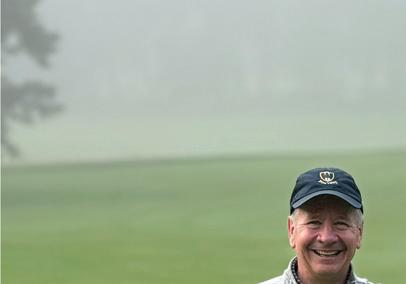
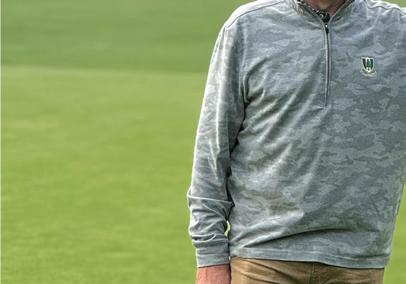

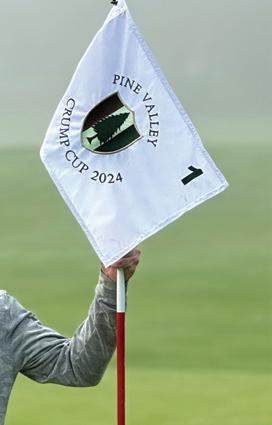

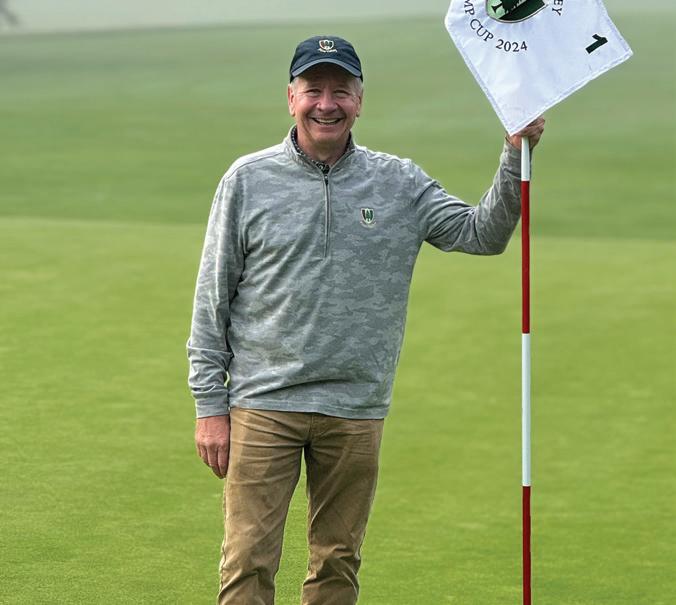
assignment that has become part of the club’s mythology. “When I get old enough to work, I would like my occupation in the field of being a golf course superintendent,” it began. “This job would mostly deal with working outside on days that sometimes get up to 100 degrees. The different things that I would have to be familiar with on a course would be soils, fertilisers, irrigation, drainage, insects, insecticides, turf diseases, fungicides, weeds, herbicides and tools ranging from hand tools to complex hydraulically operated fairway mowing units. On days that it rained, I would probably stay inside working on tractors and mowing equipment.
“I like the occupation because I will mostly deal with working outside in the fresh air, and I would also like this job because it takes a great deal of hard work. Also, this job sometimes deals with getting up early, and I like to get up early before anyone else. I would much rather have this kind of job than working in some air-conditioned food store.”
Rick went on to write about the importance of a good education and wanting to go to college to study “agronomy, horticulture, entomology, plant pathology, landscape architecture, construction, accounting, meteorology, civil
engineering and mechanics as well as public and labor relations.”
The job had many advantages, he wrote, but “there is one big one, and that is being proud of all the work I do.”
Rick’s teacher must have been a tough grader. He got a B. I assume the other kids went on to become Nobel Laureates and Olympic gold medalists because that’s the equivalent of Rick’s delivery on his promise.
When club president Jim Davis announced Rick’s retirement at Pine Valley’s spring dinner in May, he gave him a new set of golf clubs and a Pine Valley green jacket symbolic of membership.
“Welcome to the club, Rick,” Davis said, and all the handkerchiefs came out. I think the members are still applauding.
The successor as head of agronomy, Adam Wilkins (who had been an assistant superintendent at Pine Valley 2005-’10) is off to a great start. The course is in firm and fast condition, as good as ever, and why wouldn’t it be? Wilkins was trained by Christian, who was trained by Bator, who was trained by Steiniger. Better than working in some air-conditioned food store.


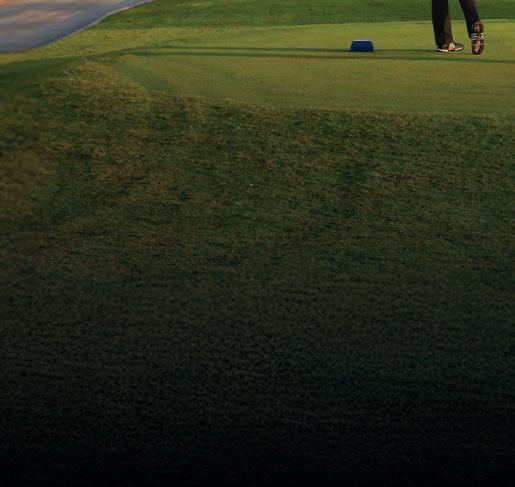






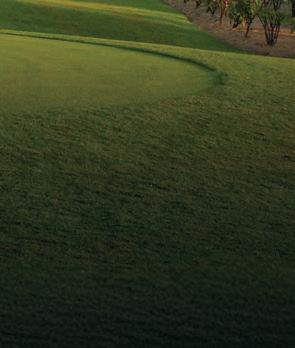



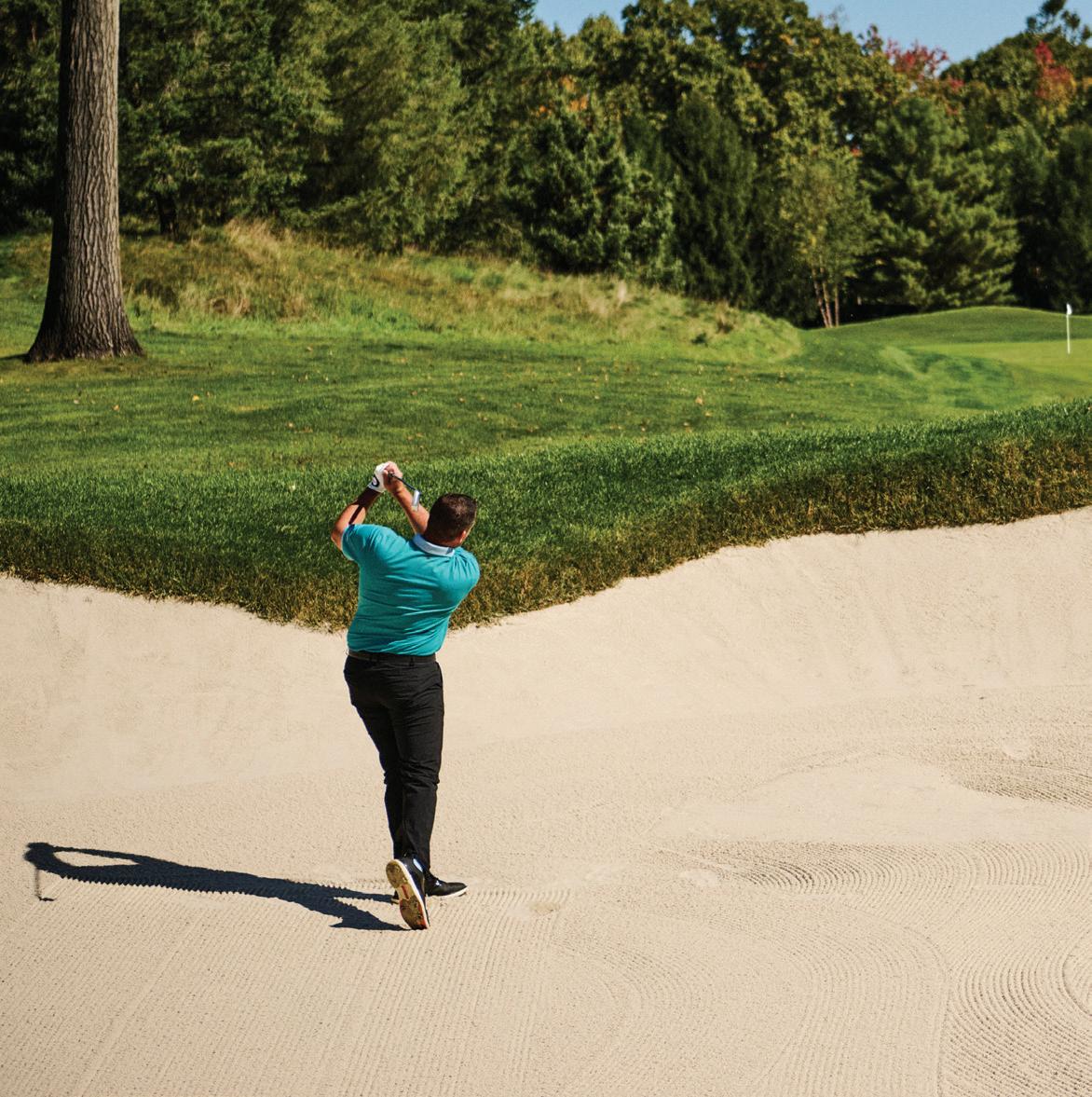
EDITED BY RON KASPRISKE

“Your toes are in the sand, but the mistake is to get in a bunker mind-set. From this lie, don’t dig in. Stay light on your feet and keep your weight 50-50. Finally, don’t hit down on the ball so much. Try to ‘sweep it out.’ That’s how you park one on the green from a fairway bunker.”
BIRNBAUM, One







With Gary Woodland’s health greatly improved, he can focus on performance
BY DAVE ALLEN
GARY WOODLAND’S BALL speed hit 197 miles per hour during one range session this year, something he hadn’t produced since joining the PGA Tour in 2009. Making that accomplishment more remarkable is that Woodland turned 40 last year and is less than two years removed from having surgery to extract a lesion on his brain.
“I’m living close to 190 miles per hour now,” says Woodland, the 2019 U.S. Open champion. “I’m hitting it as far as I was when I was 25, which is awesome.”
Woodland, who currently ranks in the top 10 on the PGA Tour in clubhead
speed (125.8 mph) and ball speed (185 mph), credits his swing coach, Randy Smith, for reinvigorating his driving game. Smith helped restore the athleticism in Woodland’s swing and, more importantly, his confidence. The two reunited late last season after being apart for 13 years.
“His swing just wasn’t the same,” says Smith, one of Golf Digest’s Legends of Golf Instruction and swing coach to world No. 1 Scottie Scheffler. “The speed wasn’t the same. The attitude about hitting the ball was very different. He seemed very defensive, especially with the driver.”
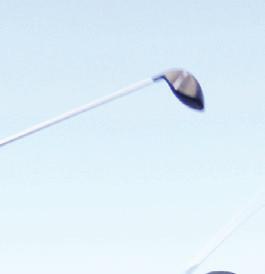

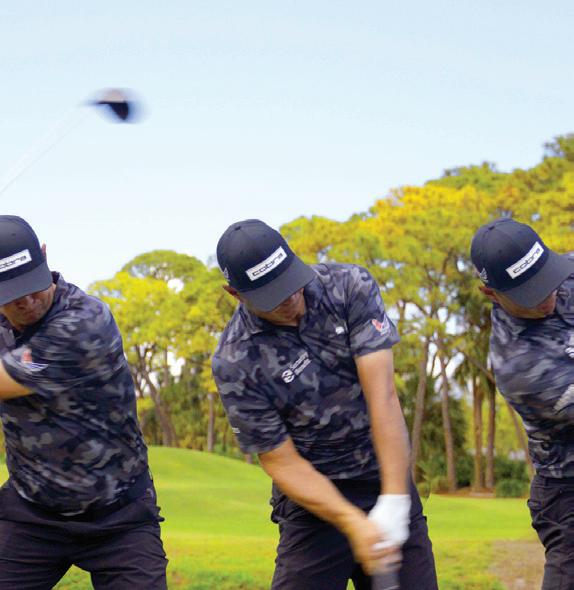

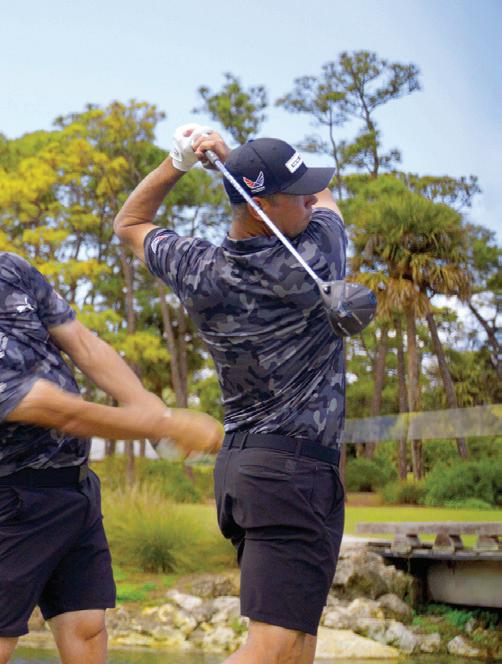
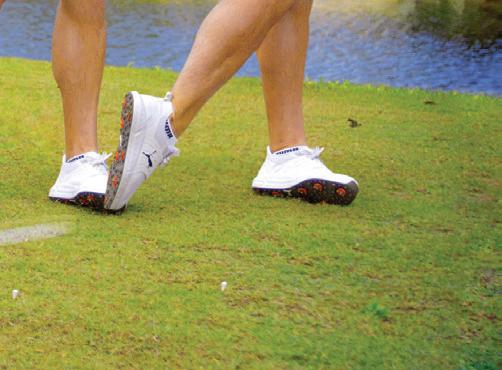
BLAST OFF Adjustments to Gary Woodland’s setup gave him a real power boost.
The first order of business for Smith was to get Woodland back into a more athletic setup that would allow him to improve the speed and movement he needed without having to think about the swing. First, they widened his base and squared off his back foot (above, first image) because his stance had become too open. They added a little more spine tilt away from the target to help him launch the ball higher. They also strengthened his left-hand grip to where he
could at least see one knuckle when he looked down. His grip had become so weak, he couldn’t feel the clubhead as he swung down into the ball.
“By strengthening my grip, my speed went up instantly,” Woodland says. “My dispersion came down, and once that got better, I could swing harder again with more confidence. I don’t have to do as much to square the face. It just allows me to be me.”
Woodland estimates his clubhead speed is up three to four mph from this time a year ago. His driving distance (313.8 yards) is about the same, but that’s because he’s now
able to dial it back to provide a little more accuracy, he says. Through the West-Coast swing on the PGA Tour, Woodland was averaging 324 yards. The four-time tour winner also got a boost to his confidence with a T-2 finish at the Texas Children’s Houston Open in March.
“With Gary, he’s got all of the physical attributes,” Smith says. “The tools are in there. It’s a matter of getting him to feel the weight of the clubhead, trust it, and then deliver it with as much speed as possible. Don’t be afraid to let this thing go. Once he was able to do that, golf became fun for him again.”
Your opponent is way up in the match but has to leave. What do you do if he offers a tie?
BY RON KASPRISKE

GOLF HAS ALWAYS BEEN grounded in good sportsmanship. There are all sorts of examples of respectable conduct naturally occurring during a round— things such as agreeing to play out of turn when it has no bearing on the outcome, tending the flag for a group, or helping an opponent find his or her ball. Most matches start and end with handshakes (even when you want to strangle someone with your putter).
All of this is great for the game, but it turns out there are times when trying to be nice or polite actually can land a golfer or golfers in violation of the Rules of Golf. For instance, before a round starts—so there are no hard feelings if one side of a match is a little stingier than the other with conceding putts—you and your opponents are not allowed to predetermine the length of a putt that would automatically qualify as holed. If you
did come to an agreement that any putt “inside the leather” was considered good, and you started a match in some formal competition, both sides would be disqualified for purposely ignoring a rule. Another thing you can’t do is decide to employ a Model Local Rule when it’s not enacted by the course or committee. An example would be, as a way to save time, allowing anyone who hits a shot out of bounds to use the new lateral-relieflocal-rule option. It’s a tough break, but you’ve got to replay from the previous spot, even if that means walking all the way back to the tee.
GENTLE-GOLFER’S AGREEMENT?
There are times to be accommodating, but this isn’t one of those times.
Where things tend to get a little confusing is what is allowed in terms of concessions in match play. Back to the scenario pre -
sented in the headline, your opponent has a big lead with a handful of holes to play. The loss looks inevitable, but then your opponent informs you he has to leave early. He graciously offers to call the match a draw. Should you agree to it?
Strictly speaking under the Rules of Golf, the answer is, don’t be a sucker. While this might seem like a generous offer, your opponent actually must forfeit the match for leaving early. He should be in the loss. Keep in mind, so long as it doesn’t delay a competition, you both can agree to stop a match for any reason and start it up again at another time (Rule 5.7). However, if he wants to stop and you don’t, the match must keep going or he loses.
It’s also important to note that while you can concede a stroke, a hole or even a match, you can’t concede multiple holes at one time as a way to speed up the outcome.















• O cial EGF Handicap (GHIN), recognised worldwide

• Discounted green fees at all UAE golf clubs
• Play in events/competitions and receive awards
• Third party and property damage golfer’s insurance egfgolf.ae




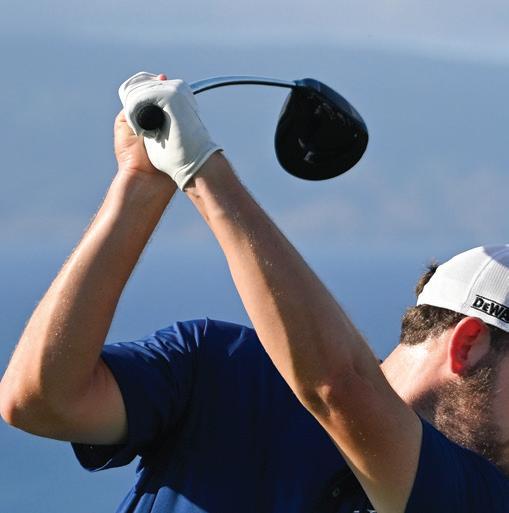

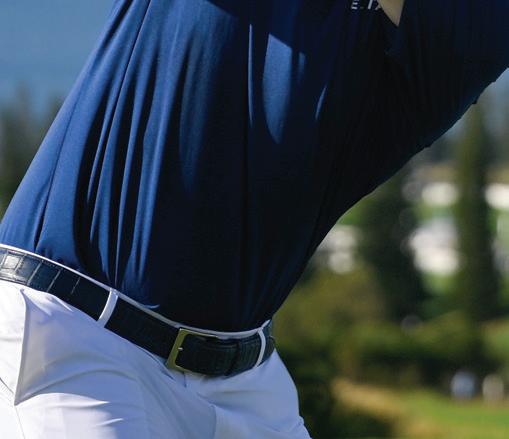
Patrick Cantlay has some advice to improve your rhythm
BY LUKE KERR-DINEEN
IF YOU WERE TO RANK THE two things that golfers want most for their golf swings, they’d probably say more power is No. 1, but a not-so-distant second is better tempo and rhythm.
If putting a smoother swing on the ball is your goal, then you should listen to what one of the best ballstrikers in the game has to say about it—eight-time PGA Tour winner Patrick Cantlay. His qualified advice starts with taking extra time as you transition from backswing to downswing.
At a recent clinic, Cantlay said it feels like he’s “waiting” a beat before starting down, like his club comes to a complete pause at the top of the swing (above) even though he knows it doesn’t truly stop. The feeling of an unrushed transition is the key to his smooth speed down and through the ball.



“It gives me as much time as possible to get speed at impact,” Cantlay said of his transition move. “Everything feels like it’s building right until the club gets to the ball.”
To be clear, Cantlay doesn’t want you to think of your swing as having two parts (a backswing and throughswing). Rather, it should be one continuous movement that slowly builds into top speed around impact—and keeps going into a fully unwound finish.
Another thing that can help improve your rhythm and tempo, he says, is this thought: Don’t hit the ball; swing past it to the finish.
DON’T BE IN A RUSH
Let the momentum of your swing slowly build.
“I try to swing all the way into the follow-through with no real inhibition,” Cantlay says.
Use these three strategies when waiting becomes a real issue
BY LYNN MARRIOTT AND PIA NILSSON
the Farmers Insurance Open in January took well over five hours to complete, drawing the ire of on-course TV commentator Dottie Pepper, who said: “I think we need a new word to talk about this paceof-play issue, and it’s respect. Respect for your fellow competitors, for the fans, for broadcasts, for all of it. It’s just got to get better.”
Pepper might as well have been speaking for all of us, as slow play is a major issue at every level of golf. Should you be victimised by slow play during your next round, have a strategy in place to remain in control of your physical, mental and emotional state. Here are three things we recommend to remain even-keeled and not allow golf’s snails to spoil your round.
1 KEEP YOURSELF BUSY
Instead of getting annoyed at the group in front of you, look away and do something to prevent negative emotions from boiling up. Talk to one of your playing partners about a recent trip or what you plan to have for dinner. If you’re not a talker, scroll through pictures of your loved ones on your phone. We’ve had players entertain themselves by counting the dimples on their ball or doodling in their yardage books. The point is, keep yourself entertained.
When it’s nearing your time to finally tee off—say, about a minute or two out—start getting loose. If you’ve been sitting around in a cart or standing still for several minutes, your body is liable to get tight, and it’s easy to lose

your feel and sequence of motion. The hips are especially vulnerable. An effective stretch is standing leg circles. Brace yourself with a club or the cart and make circular motions with each hip and leg. This works the inner thighs, hip abductors and glutes and helps get these important muscles ready to perform again.
Most important, do not tee the ball up until it’s your turn. The worst thing you can do is peg it and then spend several minutes thinking about the shot while waiting to hit. This disrupts the
WHILE WE’RE YOUNG! Lynn (left) and Pia will get you through this slog.
sequencing and timing of your preshot routine, which begins when you’re committing to your decision. Keep your good-performance routine consistent, no matter what—and make sure your body is activated before you get back into “play mode.”
—with dave allen
LYNN MARRIOTT AND PIA NILSSON, two of Golf Digest’s Legends of Golf Instruction, are co-founders of VISION54 in Scottsdale.



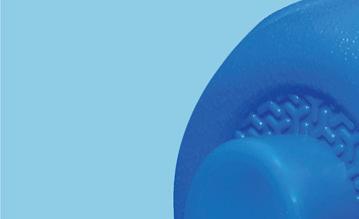
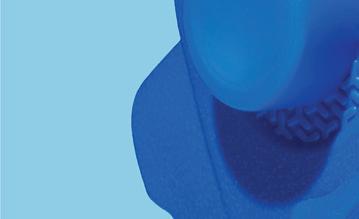
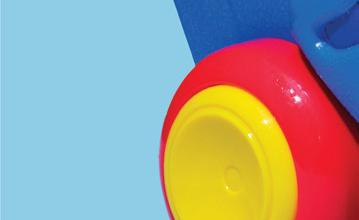





EDITED BY PETER MORRICE
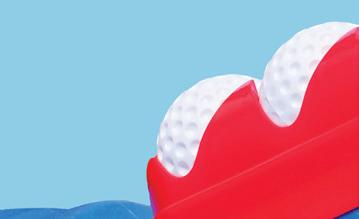
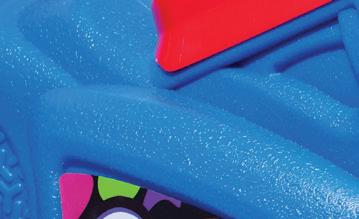
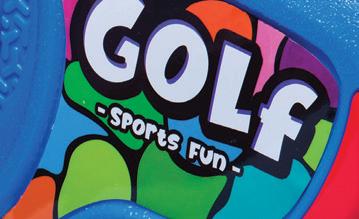
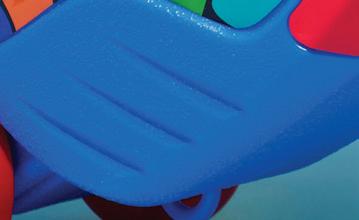


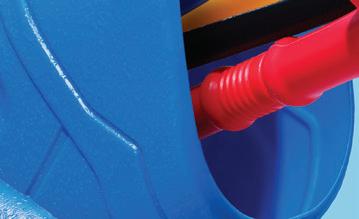
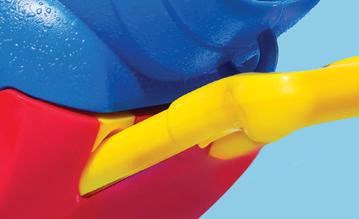



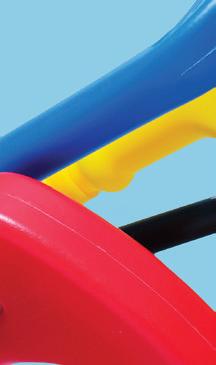




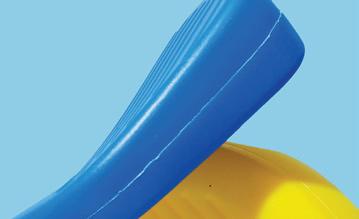
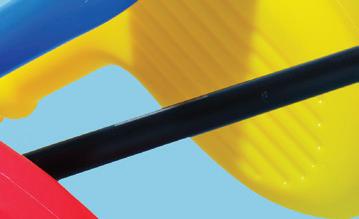

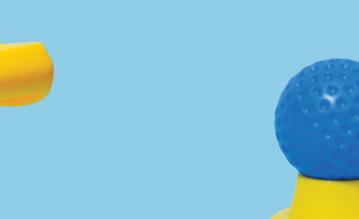













Mark Twain once said, “A baby is an inestimable blessing.” Whether that holds true for everyday players using the baby—or mini—drivers popping up on tour and on retail shelves is a different thing altogether. The recent minidriver craze has been a trend (or a fad, depending on your viewpoint) more than a decade in the making. Ever since Phil Mickelson unleashed the Callaway “Phrankenwood” at the 2013 Masters and followed it by using a 13-degree version of the company’s X Hot 3Deep in winning the Open Championship at Muirfield later that year, smaller drivers have been something of a thing, albeit on and off.
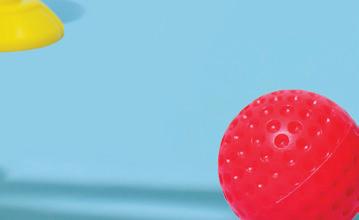



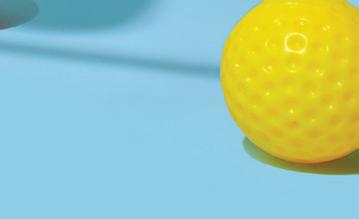



Equipment manufacturers, mostly TaylorMade, have dabbled in the mini driver game in the marketplace with limited success. Now, however, it seems almost everyone wants in.
Recent introductions from Callaway, PXG, TaylorMade and Titleist (right) indicate the category might have legs.
If adoption among the masses is anything like it is on tour, expect some of these clubs in the bags of your weekend foursome. At this year’s Players Championship, 20 mini drivers were in play, with Justin Thomas and Tommy Fleetwood among those wielding them.
Being popular or trendy, however, does not always translate to usefulness. Tour pros are skilled enough to handle pretty much any stick expertly. Everyday players are different. The oversize head of a driver offers needed comfort and forgiveness. The loft of a fairway wood provides necessary launch. Is there even a need for a mini driver?
Chandler Carr, manager of product creation for TaylorMade, is steadfast that there is an audience for them and good science behind it.
“A smaller head allows us to do more with the mass to create an incredibly low balance point,” he says. “The centre
of gravity (CG) is in a good position, so your mis-hits aren’t as penalising. You can have a lower tee height; you have a smaller head size but still a relatively large effective hitting area, and then a shorter shaft. You’re kind of checking all the boxes of more repeatable contact by shrinking your driver down.”

The construction of mini drivers is quite different from drivers and 3-woods. A driver head is typically 460 cubic centimeters and the shaft 45.5 inches long. A 3-wood is about 180cc and 43 to 43.5 inches. As you would expect, the mini is in between, at 280 to 340cc and about 43.75 inches. (See an example of relative head size, below left.)


The larger face on a mini driver makes it more forgiving than a 3-wood, which is a plus for golfers dealing with contact issues, particularly low on the face. Also, opting for a larger face makes catching a piece of the face easier on severe mis-hits. The longer shaft on the mini increases the potential for extra distance, too.
But beware, the lofts are stronger on minis, as low as 11 degrees and up to 13.5 degrees. For players who struggle to get shots airborne, this can be a problem. However, for those with difficulty hitting the driver high enough, it could make for a viable tee-shot option, albeit with a forgiveness sacrifice. That is leaving some clubfitters wary.
“A few people definitely come in looking for it,” says Woody Lashen, co-owner of Pete’s Golf, a perennial Golf
HOW THEY STACK UP
Here are current models (from top to bottom) of a Titleist 3-wood, mini driver and driver.

IN Some major manufacturers are betting on the minidriver craze this year.
Digest 100 Best Clubfitter. “However, when we explain we can make a 460cc driver at 43 inches that will help their control problems a lot more than a mini driver, that’s what they buy.”
Lashen’s facility, however, is one of the premier club builders in the game and gets the internal weighting right. A shorter driver is not as simple as just lopping a couple of inches off the shaft. If that’s the alternative, the mini driver is the better move, Carr says.
“Your moment of inertia is greater with a shorter driver, but your efficiency is not as good,” he says. “And your CG projection on a higher-lofted driver is higher. So now this golfer with a 43inch shaft and a 12-degree driver head is going to be hitting it shorter than the mini driver because it’s spinning too much. The recreational golfer needs distance, and the launch and spin are more efficient in a smaller head.”
Ultimately, the decision is a personal one. Link up with a qualified fitter to understand if there’s an edge with one over another. Sound advice—whether about babies or golf clubs—always saves you headaches in the long run.
—E. MICHAEL JOHNSON






Attractions



Activities
Dining
Health
Education
Entertainment
Real Estate
Hotels & Resorts
Shopping
The

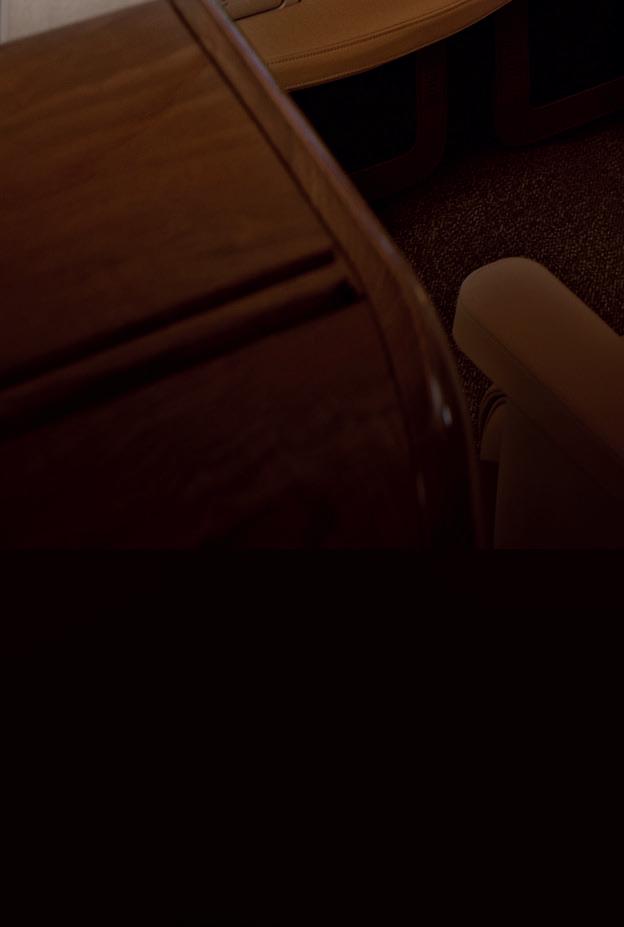


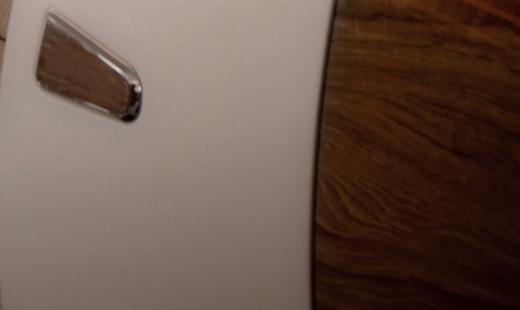










Here’s a hint: It ain’t distance
BY MIKE STACHURA
Wha t’s the most important performance metric when you’re looking at new irons? In this era of ubiquitous launch monitors, it’s easy to get excited about things like ball speed or dispersion or even smash factor (ignore that, please) as the readouts flash by. But there’s a data point buried in your launch monitor report that you should be paying attention to because it might be the difference between hitting greens and just visiting them on the way to the back bunker.
It’s called descent angle, or landing angle, and having a steep enough landing is the key to holding greens. Research from Ping characterises three potential ranges for what it calls “stopping power” (low, mid and high). For average-golfer speeds, the range of landing angles runs from the mid 30s to the high 40s, depending on whether you’re looking at low, mid or high stopping power. Across most speeds, a landing angle near the mid40s will yield shots that stop rolling closer to where they land.
As Chris Broadie, Ping’s head of fitting science, explains on the company’s Proving Grounds blog, “Since players with fast swing speeds generate higher spin, a steep landing angle might not be their highest priority in an iron fitting. However, many slower-swing-speed golfers can benefit from more stopping power.
“The standard loft on a 7-iron plays a critical role in these landing-angle guidelines.”
That raises a curiosity, given the specs of modern irons. The lofts of 7-irons considered for this year’s Hot List testing ranged from 25 to 34 degrees, and typically those irons with
the strongest lofts were designed with thin, flexible faces for more ball speed and less spin, two keys to distance. Those flexible faces also are lighter and can lower an iron’s centre of gravity, and both of those characteristics can help shots launch higher for ultimately a more green-holding trajectory. Still, when we look at specific player data from this year’s Hot List summit, those landing angles don’t always work out. Calculated by Rapsodo’s MLM2 Pro launch monitor, we see one clear thing: The loft on the 7-iron needs to be dialed into each golfer’s swing, and we’re not talking about just clubhead speed.
You can get some general ideas by looking at the 20 players in our lowand middle-handicap groups. All of these players hit the same models of irons in the Players and Players Distance categories, two categories where the clubs are similarly compact in look but often significantly different in loft. Players irons often feature weaker lofts (32 degrees and higher) and clubfaces designed not to flex at impact, while Players Distance irons feature stronger lofts (30 degrees and lower) with springier faces. Overall, the data from the MLM2 Pro showed that the lower the 7-iron loft, the flatter the landing angle. For 7-irons with lofts of 30 degrees or less, the average landing angle was 3.5 degrees flatter than 7-irons with lofts of 33 degrees or more. However, carry distances weren’t wildly different, at least not consistently.
The gist of the issue is this: Stronger lofts and flexible clubfaces can produce more ball speed and perhaps more distance, but carry distance is significantly impacted by each player’s clubhead speed and the way he or she gets the clubface back to impact. Think
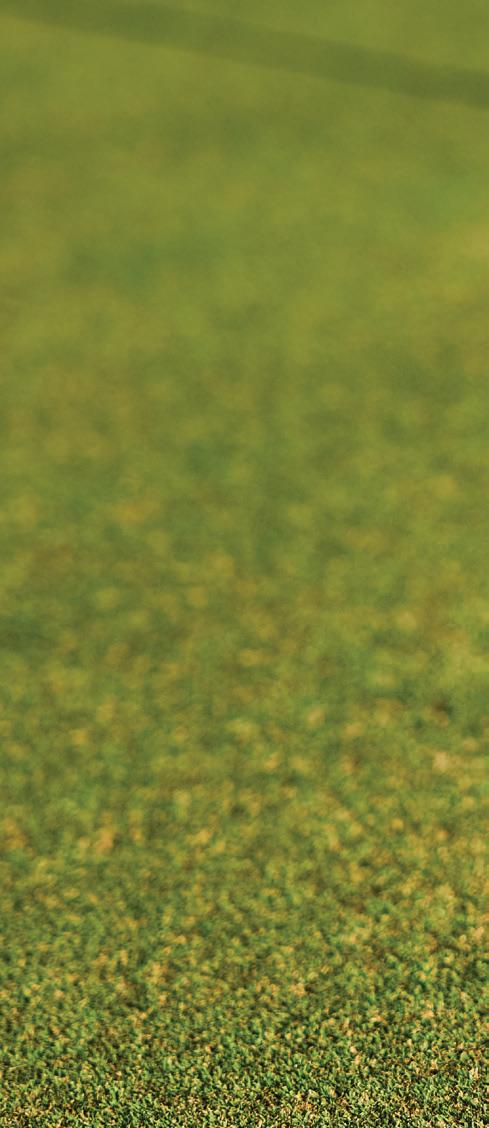
of how a better player naturally delofts an iron at impact, for example, or how a less-skilled player often tries to help the ball into the air.
Let’s look at three different players and their data from the MLM2 Pro on selected 7-iron shots.
Robert Shaw, a 2-handicap, hits his 7-iron about 180 yards with a PGA Tour-level launch angle around 16 degrees (meaning he compresses the ball and delofts the club at impact). He gets a much steeper landing angle with weaker-lofted clubs (like most Players irons), but even the stronger-lofted

Players Distance irons will land at a serviceable 45 degrees with five to eight more yards of carry.
David Ilsley is 30 yards shorter and three decades older than Shaw, but his handicap is just two strokes different. His slower swing speed, coupled with a launch angle that’s more like a PGA Tour player’s 9-iron, means he actually gets not only a better landing angle but also more carry distance with a higherlofted 7-iron. Example: Ilsley hit the Callaway Apex Ai200 (30 degrees) eight yards shorter than the Callaway Apex CB (34 degrees).
Skylar Frankiewicz, a former college player who’s now a 7-handicap, hits the stronger-lofted 7-irons about halfa-club further than the weaker-lofted 7-irons. Her landing angles are better with weaker-lofted 7-irons, but the real decider is spin rate. With about 2,000 rpm more spin on the weaker-lofted 7-irons, she’s getting more predictable results when her 7-iron has more loft, not less. So it’s reasonable to suggest that weakening the lofts on her irons might get her the best of all worlds: better launch, better spin, better landing angle and better distance.
In the end, it’s not a universal fact that strong-lofted irons will lead to more distance and more greens hit, nor is it the case that choosing a weaker-lofted iron without a springy face is going to be the best solution for you. Still, since golfers purchase relatively strong-lofted irons over weak-lofted irons by a margin nearing 20-to-1, it seems obvious that the smart play is to forget distance when searching for new irons, whether your average 7-iron yardage is longer than Rory McIlroy’s or shorter than Lydia Ko’s. You want your shots to stay on the green, too.
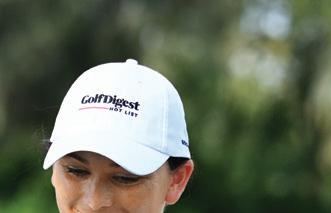

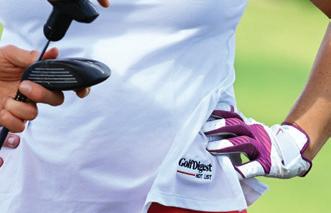


I’M A 45-YEAROLD, PHYSICALLY FIT WOMAN GOLFER. SHOULD I BE LOOKING AT WOMEN’S CLUBS OR MEN’S?
Without seeing your swing, it’s a tough question to answer, but you’ve left enough breadcrumbs for us to try. To help, we offer the case of Tricia Ruddy, a golfer with a similar profile.
Ruddy, a good athlete in her early 50s, had a handicap in the high teens. She was playing a set of women-specific clubs and decided to go for a clubfitting.
“I’d never been fit before,” Ruddy says. “I went in just wanting to leave feeling comfortable with a new set, but I was blown away by the process. I realised there are no two golfers alike, no two physiques, no two swing paths, so I let the pros do their work.”
The professional in this instance was Woody Lashen, co-owner of Pete’s Golf, a Golf Digest 100 Best Clubfitter in Mineola, N.Y. The challenge was that










Q: ZERO-TORQUE PUTTERS ARE CREATING A LOT OF BUZZ. HOW DO THEY DIFFER FROM REGULAR MALLETS? SHOULD I SWITCH?
Fitters know women-specific clubs suit only some women.
Ruddy had plenty of speed but needed a higher launch and a longer shaft. She also had some gapping issues between clubs. The result was a new 7-wood and 9-wood and an iron set where the longest iron was a 6-iron, with lighter but stiffer shafts.
“There’s nothing off the rack that Tricia could have gotten that would have worked for her swing,” Lashen says, “nothing that would have let her live up to her potential.”
Lashen says only 20 percent of the women who get fit in his shop end up with clubs designed for women. However, there are women’s offerings with plenty of tech and R&D behind them (Callaway Reva Rise, Ping G Le3 and TaylorMade’s Kalea among them) that will work for slower-swinging players.
Whether the recommendation is a women’s set or something else, the point is, go through the process. “With the technology now, I’ll never again buy clubs without getting fit,” Ruddy says.
Given the success on tour with zerotorque putters—converts include Adam Scott, Brian Harman and Lucas Glover—it’s natural to wonder if you could benefit from one of these new mallets. Of course, it’s all about trying putters to see what works for you, but zero-torque is definitely worth a look. Simply put, zero torque is a design that helps the putterface stay square to the target line—as opposed to opening or closing—by placing the centre of gravity directly under the shaft axis (above). It’s meant to assist golfers who struggle to get the face back to square or tend to make inconsistent impact.
Why is this important? Striking the ball on the toe or heel forces the face open or closed, leading to a putt that doesn’t travel down its intended line. You likely lose some ball speed, too, meaning the putt could end up wide and short. We’ve all seen that movie.
By keeping the face square during the stroke, zero-torque designs reduce the number of variables so you can focus on the real determinants of success— line and pace. This should lead to more holed putts and shorter comebackers. These putters are great options for golfers who simply want to point, click and shoot when standing over a putt.
Answers by Golf Digest equipment editors
Mike Stachura, E. Michael Johnson and Jonathan Wall

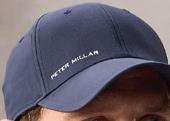

Peter Millar and eGolf Megastore are set to raise the bar in Middle East golf retail WITH HARRY GRIMSHAW
As Peter Millar launches in the Middle East through eGolf Megastore, we spoke with Dean Cheesley, CEO of eGolf Megastore, and Mark Hilton, Managing Director at Peter Millar, to hear more about the partnership, what it brings to golfers in the region, and why it just makes sense.
Dean, what was the motivation for eGolf Megastore in choosing Peter Millar as a new supplier?
We are genuinely pleased with the new Peter Millar regional partnership. Their confidence in our retail model and presence in the market said a lot. From our side, it was a straightforward decision. Peter Millar is globally respected
IMMEDIATE IMPACT
The rollout starts with key stores and wholesale partners in the UAE,and expansion across the GCC by Q1 2026.
for its quality and design, and we’ve always admired what they stand for in the world of golf and premium apparel. Adding them to our line-up just made sense. It raises the bar and fits exactly what our customers expect from us.
How do Peter Millar’s products complement your existing apparel offerings?
They just align perfectly with the brands we already carry. We’ve built a strong portfolio with names like G/ FORE, J.Lindeberg, Galvin Green, Greyson, BOSS, Puma Golf, Lyle & Scott, Jack Nicklaus and in the near future Sun Day Red. Each brings something distinct, and Peter Millar adds another layer — classic, refined style with premium craftsmanship. Their gear hits that sweet spot for golfers who care about both performance and how they look. It’s a smart, natural fit that complements, rather than competes with, what’s already on our shelves.
How does this add to the overall armoury on offer at eGolf Megastore in the Middle East? Will it be available across all stores in the region? We’re not just about selling products — we focus on creating a full golf retail experience. Adding Peter Millar strengthens our offering in a big way. It gives customers more choice at the premium end, especially those looking for something elevated but still grounded in performance. The rollout starts with key stores and wholesale partners in the UAE, where we know demand will be strong. We’ll then expand across the GCC in phases, with full availability planned by Q1 2026. That approach allows us to launch it properly and build momentum , especially at proshops across the GCC
In what way will this partnership enhance the shopping experience at eGolf Megastore?
Peter Millar brings a level of polish and consistency that golfers really appreci-



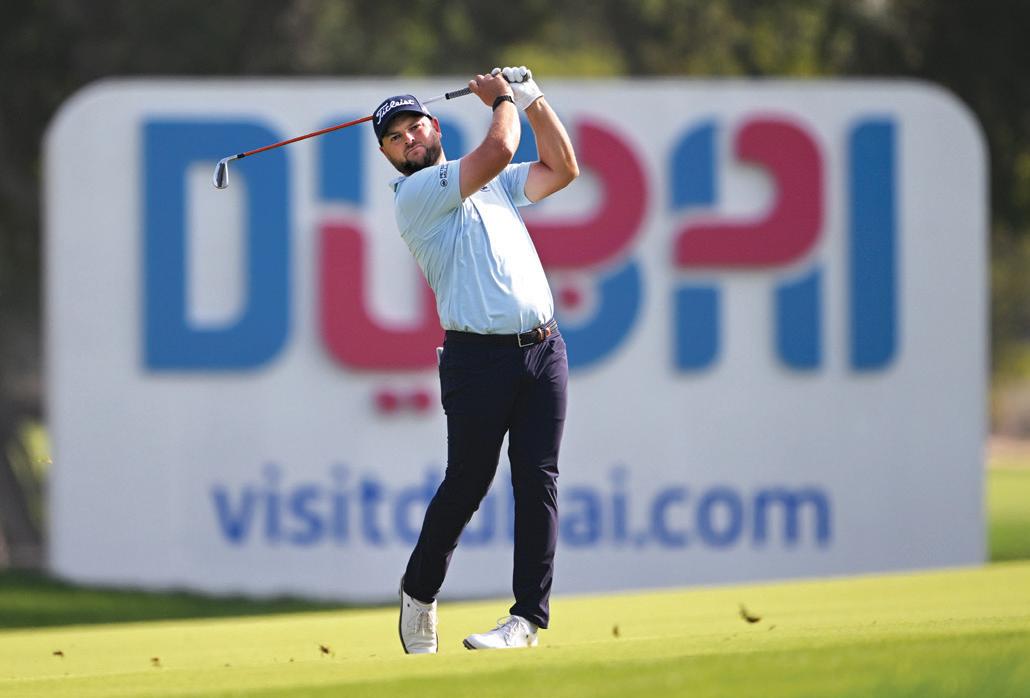
ate. Their collections are built for those who want function on the course and a refined look off it. That’s exactly where the market is heading, especially in this region. Bringing a brand like this into our mix gives customers something new and exclusive to get excited about. It elevates the experience without straying from what we’re already known for — quality, choice, and expertise.
We have a clear brand philosophy — which can be summed up as “setting the standard.”
And Mark, what attracted Peter Millar in choosing eGolf Megastore as their key partner for the region?
We at Peter Millar have admired what Dean and the eGolf Megastore team have achieved for many years. T hey presented us with so many strong options for immediate impact, along-
side a long-term strategy for growth. Peter Millar is fortunate to be found in the best golf facilities around the world and eGolf Megastore fits that bill. We are thoroughly looking forward to growing the business across the region in a true partnership.

JORDAN SMITH
The Engishman is a two-time DP World Tour winner and Peter Millar ambassador.
What does it mean to add your product range to eGolf Megastore?
For Peter Millar, it means we can present a full lifestyle off ering in the region. Peter Millar is about much more than just golf. Yes, we’re proud to be a leader in modern, stylish, performance-driven apparel, but we also off er a wide range of offcourse pieces that we know customers will be drawn to. eGolf Megastore gives us the ideal platform to showcase that range.
How does Peter Millar’s brand philosophy align with eGolf Megastore’s vision and values?
We have a clear brand philosophy — which can be summed up as “setting the standard.” That’s something we strive for in everything we do. eGolf Megastore shares that mindset. They’re committed to excellence, and we see this partnership as a strong alignment of values and ambition.



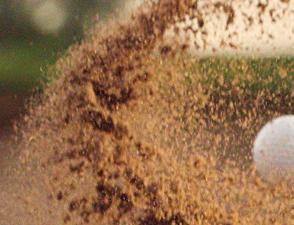

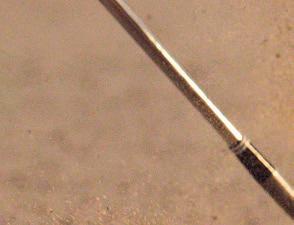
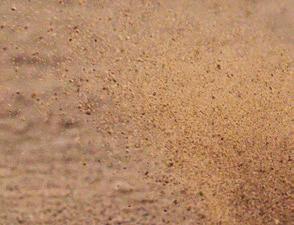

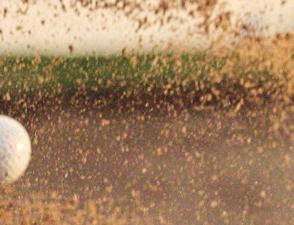

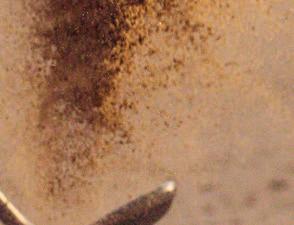


Getting your wedge makeup right takes a little effort but can save you a ton of strokes
BY E. MICHAEL JOHNSON




IN THE PRO GAME, THE wedges a player carries and the specs of those clubs is a constant discussion with equipment reps and clubfitters—and it can change week to week depending on the course. You don’t need that level of scrutiny, but having, say, only a pitching wedge and sand wedge in your bag isn’t enough.
Let’s start with why. Safe to say, you’re missing plenty of greens. Also, you hate less-than-full swings, and carrying clubs you can swing from various distances inside 100 yards helps. Plus, you’re likely hitting your 5-wood as far



as your 3-wood and your 5-iron as far as your 4-iron, so those clubs are ripe to drop and replace with a wedge or two.
We acknowledge that deciding on wedges is one of the toughest scenarios in the equipment world as there is so much to consider. Loft gapping, bounce angles, sole grinds, even shaft preferences are not immediately intuitive. Turf conditions at your course might impact the ideal wedges for you, too. Perhaps the most obvious question is: How many wedges? Ideally you should have four, including your pitching wedge. If you have a strong-



BLAST FACTOR
Keep tabs on the wedge you use in the sand and on high-spin shots. The grooves tend to wear out faster.
lofted pitching wedge (44 degrees or less), five might be better. That said, a pitching wedge, 50-, 54- and 58degree constitute a sensible makeup that provides plenty of shot options. Now let’s get to some details. What about shafts? The tendency is to just go with whatever shaft comes with the club, but that’s not always the right call. If Jordan Spieth’s clubs offer any insight, the move would be more than a single shaft. Spieth’s 46-degree Titleist Vokey SM10 has a Project X 6.5 shaft—the same shaft he has in his irons. His 52-, 56- and 60-degree, however, have a softer Project X 6.0 shaft, which adds feel. The theory is, lower-lofted wedges are used more as full-swing clubs that benefit from having the same shafts as the irons, while the sub-flex shafts help on greenside plays. For you, consider matching the shafts of your irons to your 50-degree, as that also will probably be a full-swing club.
Next come grinds and bounces. This can get a little complex, but let’s begin with the fact that they are two very different things. We’ll take them one at a time, starting with grind.
The simple explanation of wedge grind is that it is the removal of material (known as “relief”) from the sole of the club to enhance turf interaction and versatility. This allows for more creative shotmaking around the green.
The type of grind you need often is dictated by swing style and ground conditions, along with the kinds of greenside shots you like to play. Some grinds offer heel and toe relief, making it easier to open up the clubface. Others feature trailing-edge relief that reduces the effective bounce. Conversely, some grinds provide more bounce in the leading-edge area.
Wedge grind and wedge bounce in some ways go hand in hand, so you should understand the effect one has on the other. For example, a grind that makes it easier to open up the clubface will create additional bounce. A grind that promotes more of a square club-
face will lessen the amount of bounce. That brings us to bounce. Perhaps the most misunderstood thing in golf equipment is that bounce is connected to the width of the sole. No! A wide-sole club can have very little bounce.
Swing type should play a part. There’s the digger-driver who is steep, taking big divots. That player needs wedges with a lot of bounce (10 degrees or more). The sweeper-slider—somebody who clips the ball off the turf— needs wedges with a low bounce (4 to 8 degrees) as that allows the club to get

down into the ball for better contact. In between the digger and the sweeper is a golfer who takes more of a dollarbill divot. That player needs moderate bounce, like 7 to 10 degrees.
One last tip: You should frequently check your lob wedge for groove wear. Titleist master wedge designer Bob Vokey says to replace lob wedges every 75 to 100 rounds because they sustain extra wear due to their usage on spinheavy shots, like flops and bunker blasts. Bottom line: Keep a closer eye on that club than your other wedges.




Which wedges are best for you? To help you weigh your options, here are four of our Hot List testers and the wedges that resonated with them and why—in their own words.
GARY ABBOTT, 37 13-Handicap





MATT SINGER, 52 11-Handicap
Titleist Vokey Design SM10


“Very e cient in all parts of the short game. Instinctively knows how much sand to take in the bunker. Good spin upon landing. Versatility with the right grind helps brush chips with the right amount of check.”


JOHN VAMPATELLA, 54 11-Handicap
Cleveland RTZ


“Feels like you’re cheating out of the sand. I could blast the ball out or make it spin and stop. I was able to hit high spinners and low rollers from just o the green, too. Very versatile.”

Callaway Opus




RYAN WOYSKI, 46 14-Handicap
Ping s159

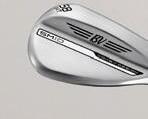
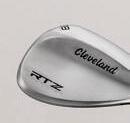




“Butter out of the bunker. It cut through the sand e ortlessly and was able to generate a bit more spin. I was able to control the height out of the sand as well. Versatile performer around the greens—just bounced o the turf with great comfort.”


“I could stop it on a dime. Incredible out of the bunker. It got right through the sand, on target and stopped every time. Just so easy to control. I got a lot of spin on the full swings.”























AGE 37
LIVES
Abbotsford, British Columbia, Canada
STORY
Five-time PGA Tour winner, including the 2025 Sony Open in Hawaii. In 2023, Nick Taylor became the first Canadian since 1954 to win his national open.
PERFECT FIT
I started messing with a hybrid at the Zürich Classic in 2023. I wanted something I could hit 230 to 235 yards. The spin and height I get with that club makes it perfect between my 4-iron and 5-wood.
—WITH DAVE ALLEN
CLUB YARDS *
Driver 290
3-wood 260
5-wood 245
Hybrid 232
4-iron 218
5-iron 200
6-iron 188
7-iron 175
8-iron 160
9-iron 149
47˚wedge 136
53˚wedge 117
59˚wedge 100
* Carry distance






















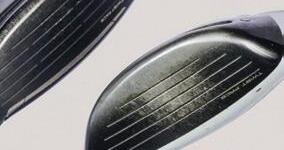







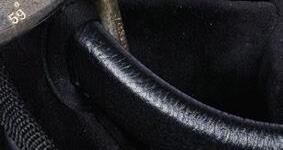









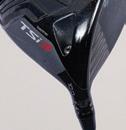









SPECS Titleist TSi3, 10°, Fujikura Atmos Blue Tour Spec 6X shaft, 45.5 inches
It has been di cult to find a driver that spins consistently for me and has the launch that I like. Everything is lower spinning. That’s why I’ve been with the TSi3 since 2022. Last summer, the face cracked, and I had a hard time finding a replacement. Luckily, I found one, and I’ve been playing it ever since.































SPECS TaylorMade Qi10, 15°, Mitsubishi Tensei AV 75 TX shaft; TaylorMade SIM2 Max, 18°, Mitsubishi Tensei AV 85 TX shaft; Titleist TSR2, 21°, Graphite Design Tour AD DI 95 X shaft
The 5-wood has been in my bag for five years. I launch it high, and it’s great out of the rough—I don’t have to worry about hitting it choppy out of a thick lie. I can chase it onto the green.











SPECS 4-iron: Titleist T150; 5- to 9-irons: Titleist T100, True Temper Dynamic Gold S400 shafts, Golf Pride Tour Velvet Align grips
The 4-iron was a change during the week of the Waste Management Phoenix Open. I wanted an extra six to seven yards of carry, and the Titleist reps were able to shave it down, so the o set wasn’t there. Right away, it took o in the nice, high window I like.
HUSKY FOR LIFE
UW was a very special time for me. They’ve sent me all kinds of stuff, including this yardage book. I’m a proud Washington grad.
JURASSIC GOLF












SPECS 47°, 53°: Titleist Vokey SM10; 59°: Titleist Vokey Design WedgeWorks, True Temper Dynamic Gold S400 shafts
I’ve predominantly been a lob-wedge chipper throughout my career, but I’ve grown to like the 53-degree because of the higher bounce, especially in Bermuda grass. I like having the versatility of two di erent bounce angles in the 53 and 59 because that allows me to use the same motion, making it easy to hit the ball solid.
SPECS TaylorMade Spider Tour Red, 3° loft, 35 inches, SuperStroke Zenergy Pistol Tour grip
I was on the cusp of losing my PGA Tour card in 2018. I had a week o before the Wyndham Championship and spent an hour in my local Golf Town trying all types of putters. I was sure I’d walk out with one, but I just wasn’t sold on any, so I stuck with the putter I’d used the weekend before. I finished top 10, kept my card and have been using this putter ever since.
My son, Charlie, loves dinosaurs. If I’m fumbling for tees in my bag and find his stegosaurus figurine, it just puts a smile on my face
KIDS’ LUCK
I switched to the Pro V1x in January 2022. The “C” on my ball is for my son and the “H” is for my daughter, Harper.

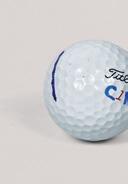


EDITED BY HARRY GRIMSHAW

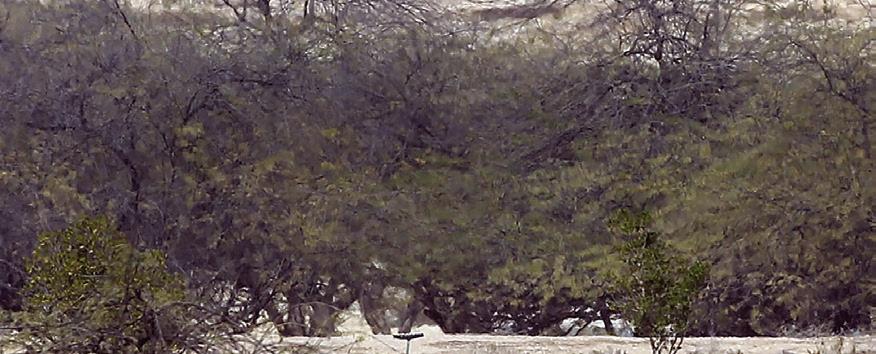
Awali Golf Club, founded in 1937, is the oldest desert golf course in the Gulf and entirely sand-based. Located in Bahrain’s oil hub, it features unique “browns” made of compacted, treated sand instead of greens. The club hosts the Bahrain Open, the region’s first Open tournament. Awali pioneered sustainable desert golf, inspiring similar courses across the Middle East. Despite its unconventional setup, it remains a respected and historically significant venue in Gulf golf.
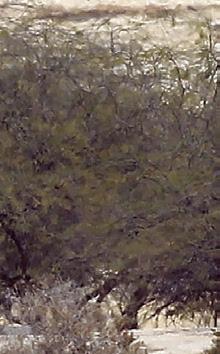

Bahrain’s Awali Golf Club rewrites the traditional rulebook with desert innovation.
BY HARRY GRIMSHAW

TUCKED INSIDE BAHRAIN’S oil heartland, Awali Golf Club holds a unique place in Gulf golf history. Established in 1937, it’s the oldest desert golf course in the Gulf, with its roots going back even earlier. Informal tournaments were already being played in the early 1930s, but the demand from Bapco’s growing international workforce led to a full 18hole layout and the club’s official founding in ‘37. What makes Awali stand out isn’t just its age or location. It’s the surface. There’s no grass on this layout, as the entire course is made of sand. What about the greens? Nope. Awali has “browns,” carefully moulded putting surfaces made from fine sand treated with a mix of diesel and motor oil. This mix helps keep the sand firm and smooth, though they still have to be relaid every week. Each brown also has a dedicated “sweeper” to rake and smooth the brown after every group.
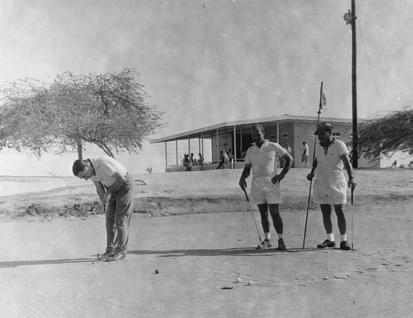
It’s old-school, manual golf course maintenance, but it works.
The tee boxes are artificial turf mats mounted on concrete plinths. Fairways are made of locally
SAND SAVE
The entire course is made of sand. The greens are called “browns,” carefully moulded putting surfaces made from fine sand treated with a mix of diesel and motor oil.
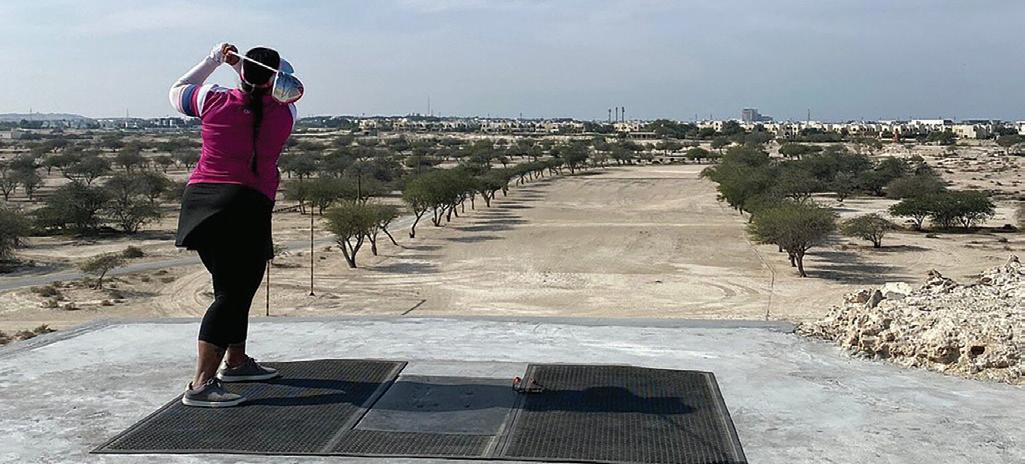
Par 4 – 474 yards
The 7th at Awali is a long par-4 with danger on the approach. Favour a tee shot slightly left to stay clear of the right fairway bunkers. Big hitters can go for the green with a long iron or fairway wood, but most should lay up around 100 yards short. Penalty areas guard both sides of the green, and anything short tends to kick right. Shallow bunkers behind and right add more trouble near the green.
Par 3 – 133 yards
The 14th is a 133-yard par 3 from an elevated tee, usually affected by wind— especially a southerly. If you’re not into the wind or can’t generate backspin, land the ball just over the front ridge and let it run on. Bunkers surround the green, and the rough left and right is thick. A shot into the oil pipes behind the green gets a free drop in the designated rough zone.
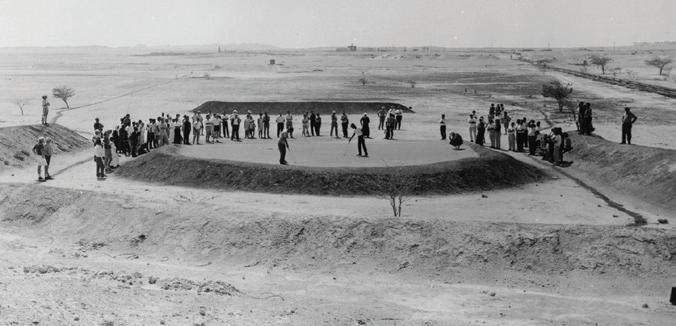
sourced sand, compacted and cleaned of rocks. Their edges are marked with either a thin cement line or a sand-and-crudeoil mixture. It’s a setup that mirrors the
club’s desert surroundings and its origins within the oil industry, but also a commitment to sustainability and making the most of the local environment.
Par 5 – 489 yards
A straight par 5 finishing hole, usually into the wind. Most tee shots won’t reach the fairway bunker, so aim at it or just right. Watch for O/B down the right. Your second shot, likely a fairway wood, should be aimed at the green but beware the rightside bunker on approach. The green is guarded by a long bunker right and a steep drop-off behind. If pitching from near the road, check the flag before playing.
Awali’s influence spread beyond Bahrain. It was the first of its kind in the region, and similar sand courses were later built by oil companies in Saudi Arabia and Qatar.
It’s home to the Bahrain Open Championship, the first Open tournament in the Middle East, which began in 1964 for men and in 1988 for women. While the setup may be unconventional for some, the competition is anything but.
Bahrain’s Awali Golf Club is a living example of how golf can adapt and thrive in challenging conditions and where the game of golf continues on in one of the most unlikely settings.

BY DREW POWELL
un derstands it’s their responsibility to rake a bunker after they hit from it, but what should they do after that? Should they place the rake inside or outside the bunker?
That’s the question we put to Shannon Wheeler, the director of agronomy at The Plantation at Ponte Vedra Beach. Wheeler has worked at The Plantation for about four years after serving as the superintendent at the nearby Dye’s Valley course at TPC Sawgrass.
Golf Digest: Shannon, where should golfers place bunker rakes?
Wheeler: The main thing is that the USGA recommends they go outside and out of the way. With a tour event, you’ve got a lot less rakes on the golf course and
so generally they would not place them anywhere a shot could end up. No matter if it’s a fairway bunker or greenside bunker, the rakes at an event will always be outside the bunker and not in line with where your shot and the hole would be.
But we tend not to put them completely outside of the field of play during recreational rounds just because the ease of the member or the player getting to the rake. You want to make it easy to keep play going, but also we tend to have way more rakes out than we would if you had an actual event. So, out of the way and equidistant apart is what we like.
I like them out of the bunker and the primary reason is, and I joke with our members, they should be out of the bunker because the handle is green. So you don’t see them.
But the real reason is our grounds crews only touch the outside areas of a bunker once or twice a week, depending on season. During the offseason, we might only mow it once a week, or we might not even mow it at all. During growing season, we can sometimes mow those areas twice a week.
The rakes get moved around enough from the membership using them during the day that we don’t see any areas where the grass has a depression or the yellow underneath them.
PLACES, PLEASE
Where you leave a rake can make a big difference for grounds crews.
Golfers should make it as easy as they can on crews. What advice would you have for golfers on where they should enter the bunker to play a shot?
Wheeler: Typically, if I’m in a bunker, I walk and grab the rake then walk back to the shortest point of entrance to get into my ball. That’s a big thing. Some bunkers are a nightmare to get in and out of, so it’s important to go to the easiest point of entrance and exit. Don’t walk in on a lip because if you’re in a soft sea, you could collapse a bunker edge by walking on it.
If the rake is left in the bunker, though, I’m possibly walking through more of the bunker to get the rake, and so I’ve got more sand to rake.
You’re making it harder on yourself. Anything else worth mentioning?
Wheeler: All in all, at the end of the day, I just want players to rake the bunker. We still see unraked bunkers from time to time. If your demo is typically more casual players, sometimes they’ll think it’s the job of the maintenance staff to rake. We put a notice out every six months or so from the green committee saying, “Hey, remember to fix your ball marks, rake your bunkers, fill your divots.” It’s always a moving target.
photograph by drnadig / getty images


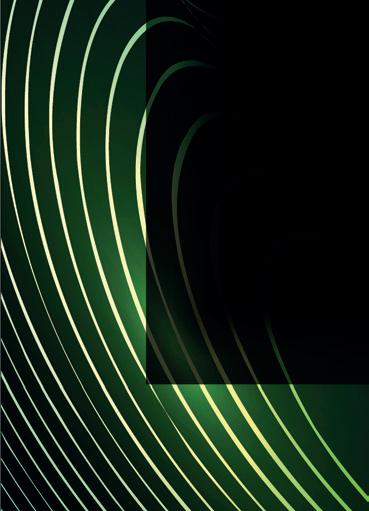















Mimi Rhodes is turning her rookie season into serious momentum on the
By Harry Grimshaw
There’s a quiet force to Mimi Rhodes. She isn’t one to chase attention, but she’s earning plenty of it.
Since turning professional less than 12 months ago, the 23-year-old from Somerset has already made some statement on the Ladies European Tour (LET), with three individual wins in her rookie season as well as a team title at the back-end of 2024.
After helping Team GB&I secure the Curtis Cup in September, Rhodes made the jump into the paid ranks immediately, and in just her second pro start, she won the Lavaux Ladies Open in Switzerland on the LET Access Series, edging out Billie-Jo Smith in a playoff.
In just a matter of weeks later, she then received an invitation to the Aramco Team Series – Riyadh on the LET. It was her biggest start as a profession-
al, and she walked away a winner at Riyadh Golf Club, teaming up with Chiara Tamburlini and Anne-Charlotte Mora to claim the team event. A sign of what was coming.
Fast forward to now, and Rhodes has become one of the most talked-about players in the women’s game. With three LET titles to her name, she currently leads the Order of Merit standings and has cemented herself as one of Europe’s most promising young hopes.
“From when I turned pro in September last year and got my LET card. I’d been close to winning a few times,” she says. “So starting this year, I kind of knew a win would come — but definitely not this early and not this many!”
Her breakout moment came in March at the Ford Women’s NSW Open. At Wollongong Golf Club, Rhodes fired
a course-record 62 in the second round and held her nerve to secure a two-shot win — her maiden LET title, a clear sign she was more than ready.
Next came South Africa, where she continued her strong form. Rounds of 65, 69 and 71 earned her a one-shot victory in the co-sanctioned LET and Sunshine Ladies Tour event, vaulting her to the top of the season-long points race.
Then came a third win — this time at the Dutch Ladies Open at Goyer Golf & Country Club — where she claimed a two-shot victory. Three wins in four starts. A stretch of form that will go firmly down in the history books.
“It was incredible,” she says. “It was just one after the other. Australia, a week off, then South Africa, then Amsterdam after a short break. It was incredible. But after that first win, it kind
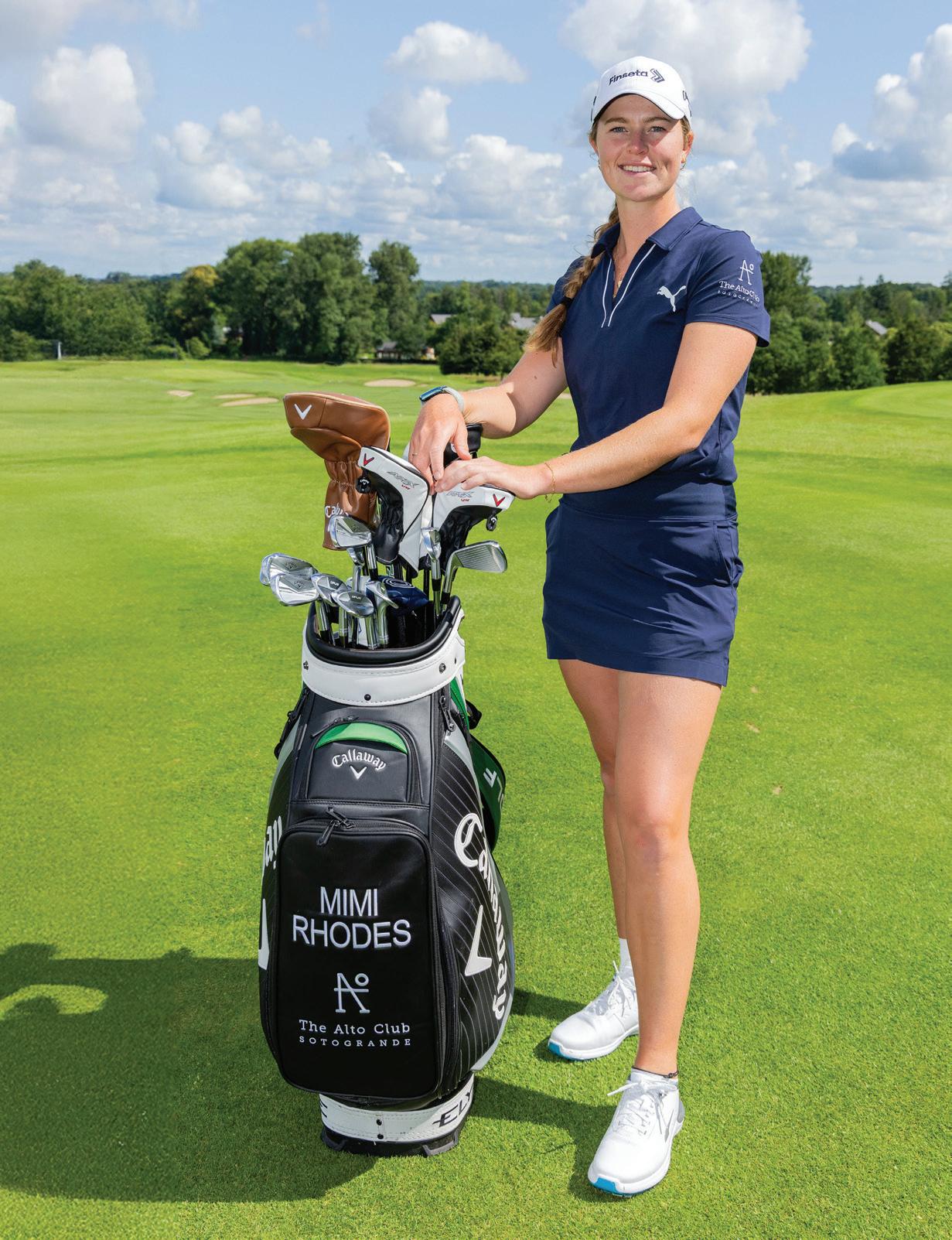
of made everything easier. I could just relax and have fun playing golf.”
Each win, she says, carried something different.
“The first in Australia and most recent in Amsterdam mean the most, but in different ways. The first one reflected all the hard work. I’d been working with a psychologist, trying to understand why I wasn’t closing out events. So to get across the line and feel like I was in control of my nerves — that meant a lot.
“Then the most recent win in Amsterdam was so emotional. I had family there. I wasn’t leading after the first two days, so it felt like I was chasing — which I actually prefer. So that was new for me. I definitely prefer less pressure!”
Raised in Sotogrande, Spain, after a few early years in Russia, Rhodes learned the game on the sun-drenched courses in one of Europe’s most golfrich areas.
“There were probably ten courses within a five-minute drive,” she says. “It was so easy to get into the game. And growing up watching Spanish players like Sergio Garcia and Carlota Ciganda — that was a big influence.
“I just really enjoyed it,” she says. “Then when we moved to England, my grandma kind of took over that role. She’s always been an influence on me and my sister, Patience. My grandma was a good golfer, and now we’re both
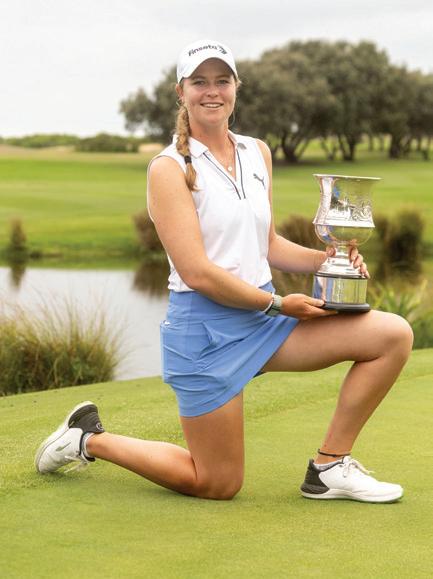
“It was just one after the other. Australia, a week off, then South Africa, then Amsterdam after a short break. It was incredible.”
members at Burnham & Berrow. Golf was kind of our escape from boarding school on the weekends!”
After four years at Wake Forest University, a U.S. college golf powerhouse, Rhodes arrived on the pro scene wellprepared. What’s followed has been an early-career leap rarely seen, certainly not at this pace.
“I didn’t actually win in college, so turning pro was like a fresh start,” she says. “No pressure, just a new chapter. I could start again and make my own path.”
Working with a psychologist in college helped Mimi understand the importance of staying present, especially in those nerve-wracking final rounds.
“You’re out there for five hours, and if you’re close to winning, your mind starts racing,” she explains. “But you’ve got to do the opposite. You’ve got to slow down, stay in the moment.
“Writing stuff down after a round helps me — even the bad stuff. I’ll go back and read it and remember how
I felt. Once it’s written, it’s out of my head and I can move on.”
Mimi’s mental approach has clearly paid off. She thrives in team environments, and a potential Solheim Cup debut isn’t far off — especially if her current form holds through 2026.
“I love playing in a team,” she says. “Wake Forest, the Curtis Cup — it’s just really fun. You get to create deeper bonds with players. You’re not out there alone. It’s a different kind of energy.”
“The Solheim Cup is on my radar now, for sure. 12 months ago, it wasn’t even one of my top three goals. But everyone keeps talking about the ranking points now.
“I’d love to be picked, but I’m not going to let it consume me. If Anna Nordqvist wants to pick me, I’ll say yes!”
COUNTER-CLOCKWISE FROM LEFT Ford New South Wales Open 2025; Joburg Ladies Open 2025; Lavaux Ladies Open 2024
Before that, she has a significant milestone approaching, her first home event on the LET. The PIF London Championship at Centurion Club will mark the first time she tees it up on England soil since her rise to the top. The event is part of the newly rebranded PIF Global Series, a five-event circuit spanning three continents, and featuring a total prize fund of $13 million with some of the most competitive fields on the LET.
Each of the three remaining events — in London, Houston, and China, offers a $2 million purse, with $1.5 million

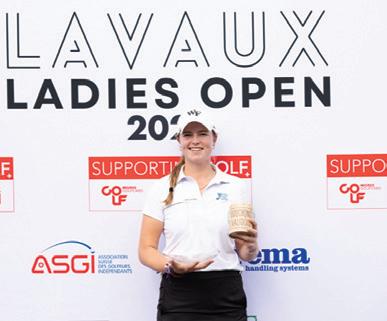
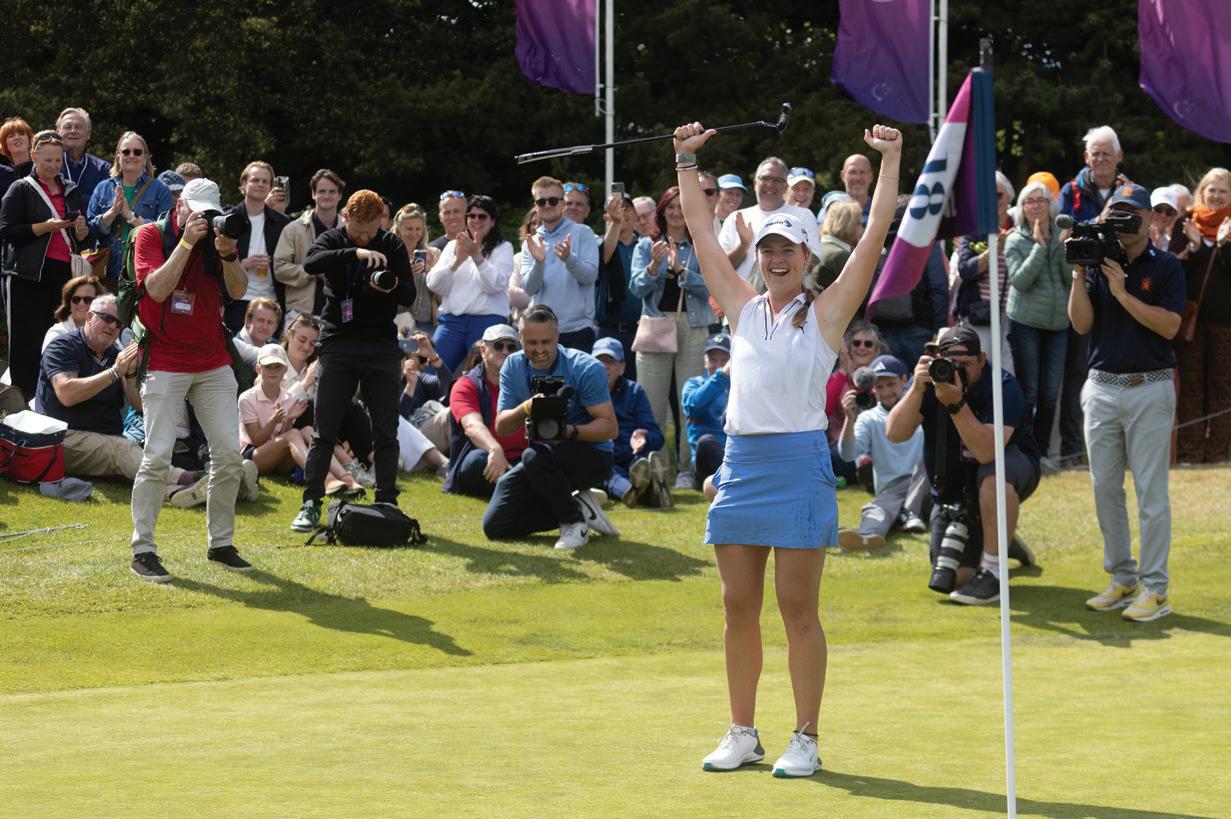


allocated to the individual strokeplay champion and $500,000 for the team event. The format tweak this year removes the amateur component, giving more professionals the chance to compete in 104-player fields.
“I’m really excited for it,” she says. “It’s close to a lot of my family, so they’ll be there to support.
“I’ve never played at Centurion, but I’ve heard great things. It’s go -
FROM TOP Dutch Ladies Open 2025; Curtis Cup 2024; Aramco Team Series Presented by PIF - Riyadh 2024
into women’s golf, it’s growing fast.
“A few years ago, I used to worry about making a living in golf. But the prize funds have improved a lot, and there’s more coverage on TV. More fans are showing up, too. I used to watch women’s golf growing up, but I watch even more now because it’s so well showcased. Bigger events, better exposure — it’s all heading in the right direction.
Mimi’s rapid success is also opening a target to the LPGA Tour. She plans to head to final stage of Q-Series in December, with an eye on securing fulltime status in the US for 2026.
ing to be amazing to play in front of a home crowd.
“The PIF Global Series events have been amazing. I won as a team in Riyadh last year and then I played there again in February. Everything about those events is just next-level — the course, the food, the overall setup. They really treat the players well, and the prize fund is a huge help! It’s great to see that kind of support going
“My main goal this year is winning the LET Order of Merit. But I’m also going to try Q-Series. I’ve got nothing to lose, and I want to see if I’m ready. It feels like the right time to go out there and experience it — I’ve heard it’s a completely different world compared to the LET. So I want to get used to it early and give myself the best chance to succeed.”
She doesn’t shout about it and she doesn’t need to. The results are saying plenty on their own for Mimi.
Jonas Mårtensson wants to change how you see golf
WITH HARRY GRIMSHAW



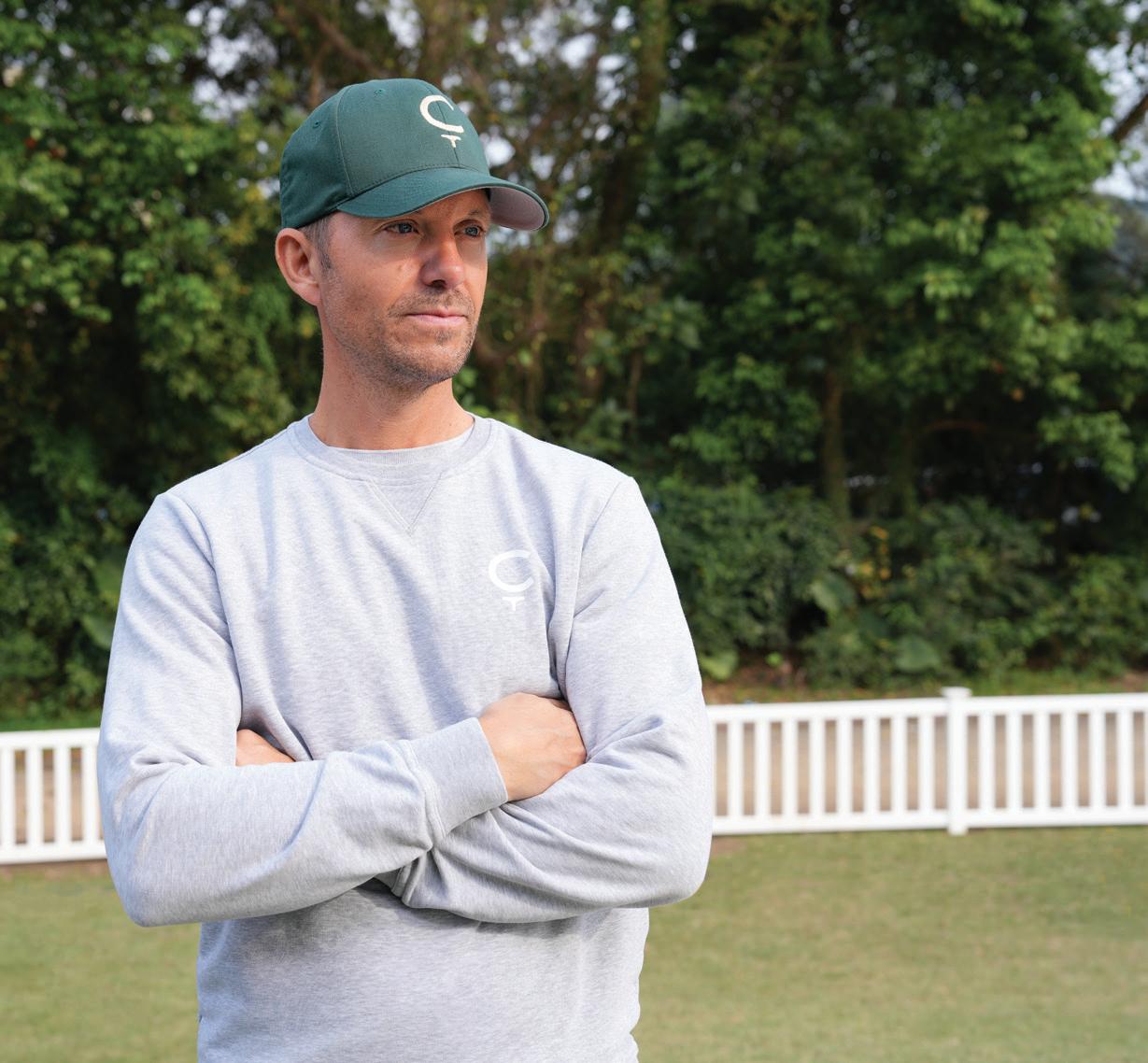

TRANSITIONING FROM gaming to golf is no easy feat, but Jonas Mårtensson is doing just that as General Manager of Cleeks GC on LIV Golf. Known for his role in creating Minecraft, Jonas talks to Golf Digest Middle East about combining his business experience with his love of golf to rebrand a team to become the “Yankees of golf”.
Jonas, you’re just over a year into your role as General Manager of Cleeks GC—has the experience lined up with what you expected? I don’t think I had any expectations. I didn’t really know what to expect. It’s the first time I’ve worked in sport, so I didn’t have any strong preconceptions about the role. But thanks to my great team, we’ve already grown a lot over the past year and gained a lot of experience together.
With your background at Minecraft and then moving across to LIV Golf, that’s quite a bold career pivot. What has surprised you since stepping into the world of sport? I’d never worked in golf before, so in a way it was a bold move. Going from gaming to golf might seem like a leap between two very different worlds – but
to me, it makes perfect sense. What I’ve always done is build communities and create platforms where people connect. That’s exactly what LIV Golf and the team format are bringing to this sport. It feels a bit like working in a start-up again – fast-paced, full of potential, and driven by passion. But because golf has always been close to my heart, working with the Cleeks team in the LIV Golf League is simply more fun.
You’ve said golf has always been a significant part of your life. What kind of golfer are you? I usually play first thing in the morning here in Spain and then have the rest of the day free. I picked up playing the game quite early – around 11 or 12 – and played until I was 18, then work and family took over for a while. Let’s just say I hit the ball long and wide! My handicap is 3. I’ve always played a lot in Spain, so when I moved here, I joined a club to play as regularly as possible. But yeah, I like starting the day with 9 holes – it frees me up for everything else.
Y ou’ve described your ambition is to turn the Cleeks into the “Yankees of golf.” What does that look like? Yes, well we believe golf is more than just a sport. We’re not just building a team – we’re creating a brand that blends tradition with creativity, connects with culture, and gives people a way to see themselves in the game. My vision is to create a global brand that people recognise instantly – whether or not they follow golf. That means delivering strong performances of course, but also bringing personality, storytelling, and cultural relevance to everything we do.
Have you been able to take lessons from building brands like Minecraft and Happy Socks over to Cleeks GC? Partly, yes. Minecraft, Happy Socks, and Cleeks are very different brands, but the fundamentals of targeting and growing a brand are quite similar.
How does the apparel line fit into the strategy? I love seeing fans and golf enthusiasts wearing Cleeks gear –it reminds me of how people proudly wear Yankees merchandise. That’s the vision: for Cleeks to grow into a lifestyle brand that resonates far beyond the world of golf.

You brought in artist Jacob Felländer—what’s the thinking behind blending art and golf into Cleeks’ identity? Cleeks is about more than just golf – it’s about culture. Fashion, art, and music are all part of the world we’re building. Collaborations like the one with artist Jacob Felländer and the streetwear brand Public Drip show how we’re redefining what golf can represent. Bringing in a respected artist felt like a natural step. We’ve got some exciting partnerships coming up in both art and fashion.
LIV is changing how golf is presented. Are you trying to do something similar with how Cleeks presents itself as a team and brand? Absolutely. We believe golf should be accessible, inclusive, and forward-looking. We want Cleeks to be more than just a golf brand – we’re positioned at the intersection of sport, art, and fashion, where new fans can feel welcome and inspired.
Is there an audience you’re focusing on? Cleeks should be for everyone –both the younger generation, who connect with the brand through Adrian and Freddy, and the older ones like me, who identify more with Martin or Richard.
You’ve also talked about wanting Cleeks to leave a legacy within the community—what does that mean? Through the league, we’re actively involved in youth and community programmes around the world – aiming to make a lasting impact. Golf has the power to inspire and drive positive change, both on and off the course.
With your experience in tech and gaming, how would you describe your leadership style in a golf setting? Has it developed at all? I don’t think it’s changed. I’m a very typical Swedish guy – straight-talking and nononsense. My leadership style hasn’t really shifted from Minecraft to golf. It’s always been based on teamwork, sharing ideas, and collective creativity.
Looking ahead, what does success look like for Cleeks GC – both on and off the course? Of course, it’s about playing a successful season – but also about inspiring new audiences and putting greater focus on the team itself, which is what truly sets the LIV Golf League apart from other tours.


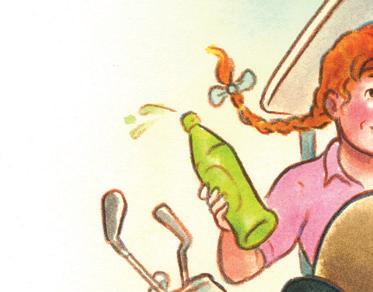
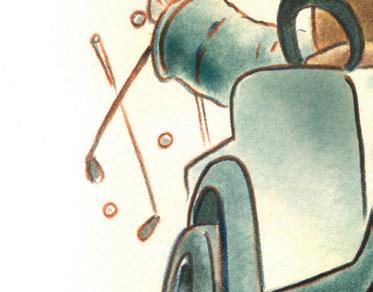
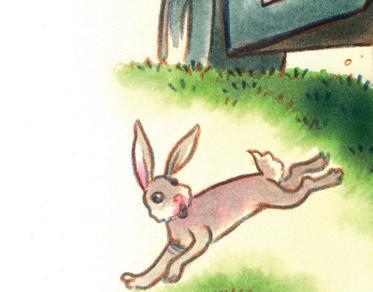
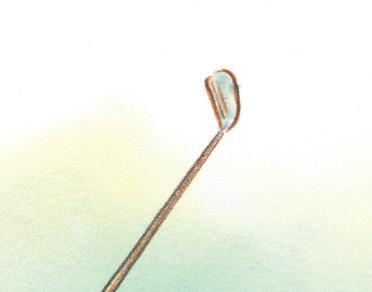
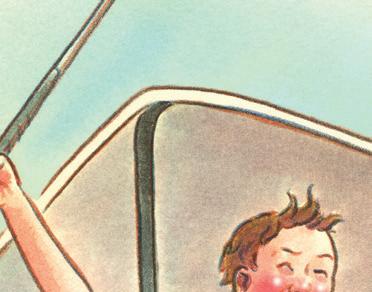

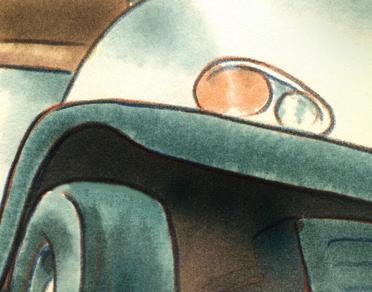
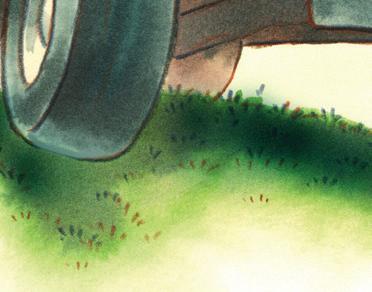

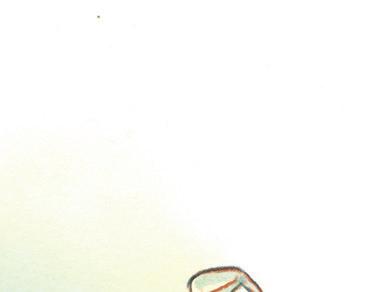
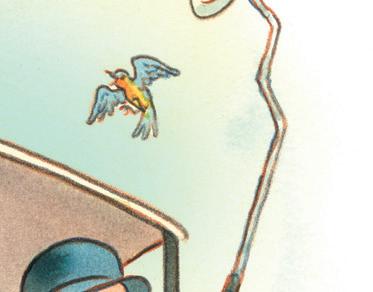
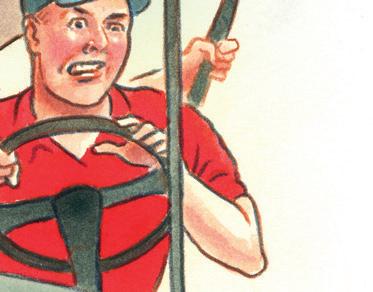

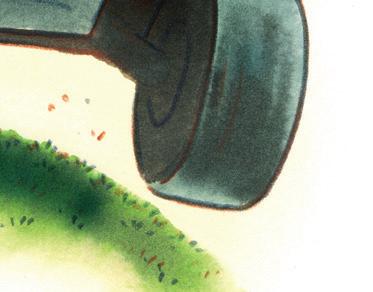

Some kids will love the game no matter what. Others require a bit more finesse.
Don’t worry if you’ve made mistakes. There’s always time to turn this cart around.
BY THE EDITORS
by Ross MacDonald

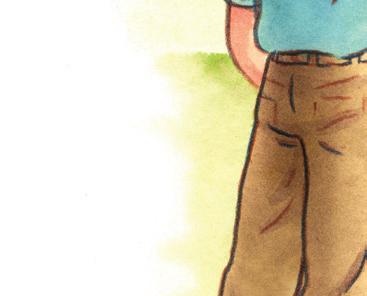


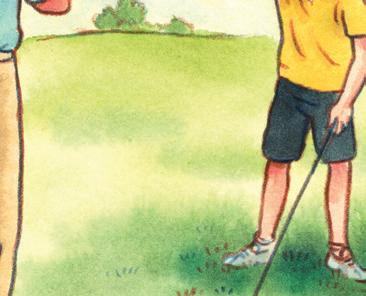

WITH PETER MORRICE
Not taking the easy way out With junior golfers, my first focus is on attitude. Physically, kids are ever-changing, so I’ll take a scrawny 10-year-old
who wants to get better over the bigger, stronger kid who’s just going through the motions. My Three-Strike Challenge is always operating in the back of my mind.

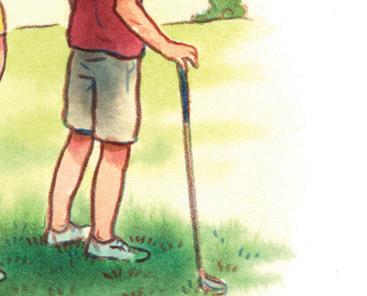

First, I ask them to show up with some time before a lesson or clinic to hit balls, chip, putt, etc. Some kids come an hour early. If they roll in just before we start— or late!—that’s strike one. Second, I’ll give them a challenge during the lesson that I know they’ll struggle with, like hitting a hook or pitching a ball that stops at a certain target. If they get mopey or try a few times and quit, strike two. Third, when the lesson is over, I’ll offer more golf, like getting them on the course for a few holes. I’m looking for their eyes to light up. If they just want to head home, that’s strike three. Now, a strike or two doesn’t mean they have no future in golf, but no strikes tell me they have something special. —Mike Malaska, founder, Malaska Golf, Tempe, Arizona.
Sean Foley, Golf Digest 50 Best Teacher
My dad took me to the range when I was a kid. I hit one teed-up 3-wood pure, and I’ve been chasing that dopamine rush my entire life. My dad never tried to teach me anything but the values of the game. For technique, he set me up with incredible instructors throughout my life, all with di erent methodologies to help me become a well-rounded golfer. Every parent, no matter how qualified he or she may be, can struggle to teach their child golf. Tiger Woods and I were on the phone once, and I asked him how Sam and Charlie were getting on. He goes, “Sam’s great, but Charlie, I just can’t get him to listen to me on the golf course. I’m trying to help him with his short game and putting, and he just simply will not do it.” As their stellar performances in the PNC Championship the past few years attest, Charlie and Tiger have obviously figured out a way to work together, but even Tiger experienced how hard it can be to be your child’s teacher. Outsourcing at least some of your child’s instruction can take the pressure o and help children fall in love with the game in their own way. —WITH KEELY LEVINS
Going with what feels natural Kids don’t come with a lot of preconceptions or fears. They use their instincts to figure out how to hit the ball. They experiment and adapt. These are amazing lessons for all of us. One thing I’ve seen only a few kids do is grip a club for the first time with the lead hand low, the opposite of a traditional grip. Why does this matter? It proves they have grip strength in their lead hand, which is a big deal, and it also helps with a couple of critical things in the swing, like hinging the lead wrist for power and lining up the lead arm and the shaft at impact for a proper strike. I also see some juniors take a split grip, like a hockey grip. I love this, too, because it means the kid’s trying to really bash the ball or find a way to swing a club that’s too heavy for them. I never change a junior’s grip right away. I want to see why they do it—and if it works. Hitting the ball flush is what keeps kids in the game. We can always adjust later.
—Gavin
Parker, director of instruction, Salisbury C.C., Midlothian, Virginia.
Acing this raw skills combine
Over the years I’ve developed a little skills combine that I run kids through. The first test is to mimic positions. I’ll swing back with the club pointing way off line at the top, for example, and ask them to copy me; then I’ll do it with the club perfectly on plane. If they can match my positions, I know they have control of their arm structure and where the club is. Next, I tell them to create as loud a swish as they can with the club. I’m not worried about what it looks like, just the natural speed. Then, I’ll have them make one-handed swings with their trail hand. If they can make contact with decent speed, that’s proof of good hand-eye coordination. Finally— and this is the fun one—I’ll see if they can pick a ball off the ground with a wedge. To do it, they must manage the angle of the face and the shaft and apply force on the ground to flip the ball up. It’s a simple task that reveals a lot. These moves tell me if they can manage a club in their hands.
—Christoff Els, director of instruction, Montclair and Millburn (New Jersey) Indoor Golf Clubs
Becoming their own motivator
Juniors are almost always introduced to golf by a parent, a friend or a coach. I want to see if they quickly start pushing themselves. That’s a sign that their passion is genuine, not borrowed. When it is, they don’t need to be rewarded. Golf is their ice
cream. Most kids are notoriously ready to move on to the next thing, whether it’s going from the practice green to the range or from a 5-iron to the driver. When a kid says to me, “One more ball. I gotta hit a good one,” that’s special. Once I see inner drive, I look for emotional toughness. Golf can be demoralising, so the junior who hits one in a bunker and wants to go hit the bunker shot, that kid is different. Great golfers don’t check out. If they have that kind of grit at an early age, they’ll be able to handle the adversity that’s always around the corner in golf.
—Renee Skidmore, teaching professional, Atlantic Golf Club, Bridgehampton, New York.
Paying attention to the game at large
There are obvious physical gifts that can forecast a junior golfer’s success, but engagement level is just as important. One sign I look for is how big a fan they are of professional golf. As a kid, I was obsessed with Adam Scott; I tried to swing like him, act like him, everything. Juniors are great imitators, as my old boss, Jim McLean, used to say. When I see a kid on the range trying to swing like a certain tour player or pretending to putt against Scottie Scheffler to win the Masters, that gets my attention. I’ll ask juniors if they watched the tour event over the weekend. Some will say, “No” or “A little bit,” but sometimes a kid will say, “Yeah, Jordan Spieth finished T-19. I was so mad.” When they’re fans like that, it usually means their investment in their own game is higher. —Ryan Hager, director of instruction, Plainfield Country Club, Edison, New Jersey.
Thinking in extremes
It might sound counter-intuitive, but one thing I like to see is impatience. I’ll take kids to the putting green and after a few instructions, one kid will sometimes peel off and just start rolling putts. That’s independence and curiosity—two great traits. Experimenting is another. I might ask how you would hit the lowest possible shot to some target. When kids say they’d putt it because the ball never gets off the ground, that’s pretty good. Highest shot? Put it on a tee and use a wedge—that’s critical thinking. I also like to see self-exploration, like if a kid is hitting it off the heel, they might ask what would happen if they hit it off the toe. Kids who think in extremes understand the middle faster. Paxton O’Connor, director of instruction, Desert Mountain Club, Scottsdale
Trillium Rose, Golf Digest 50 Best Teacher
I coached a five-year-old who asked to bump our sessions from 30 minutes to an hour. He’s one of those kids who’s loved golf from the start. My six-year-old is not one of those kids. Helping her love golf has been a test for my husband and me. We’ve learned to let her do whatever she wants at the range if she isn’t bothering anyone else. She wants to take all the tees and build a fort? Great. She wants to hit one? Great. She wants to sit in the cart and drink lemonade while I hit balls? Great. I want every association she has with the game to be pleasant. She likes activities with other kids, so we signed her up for group lessons. We dropped her o like we drop her at soccer. We prayed she’d like it, but you can’t let your kid see that, because that’s pressure. It’s not fair to them, and it could backfire on you. This summer, we took her out on the course with a friend. The other kid’s mom and I grabbed a cart and kept an eye on pace of play while the kids hit it, ran after it and hit it again. I rarely talk about technique with my daughter. If one day she wants to learn more about the swing, she knows I’ll be right here for her.—KL

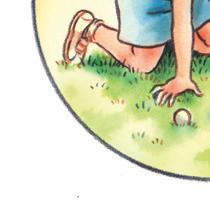
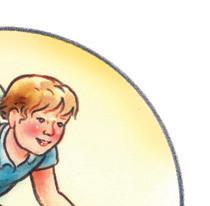


Davis Love III, Hall of Famer
Atlanta Country Club recently posted a photo on Instagram of the renovation of the sixth hole, and I immediately thought: Those rocks are the best place to look for golf balls on the whole golf course. That was my association with that hole because my dad, who was the pro there, would take us out on Mondays when the course was closed. When we got to No. 6, my brother Mark and I would get bunker rakes and gather balls from under the rocks. Dad made golf fun for everybody—that was his mission in life. We’d take a fishing rod with us and stop playing to go fish. Mark (who caddied for me and co-founded our golf architecture firm) also fell in love with golf as a by-product of those casual outings. When I first introduced my son to the game, I let him drive the cart, and play in the bunkers with the rake. My granddaughter, well, at first her favourite thing to do was ride in the cart and fill divots with sand. She also liked to look for mushrooms. She’d set up to the little mushrooms like they were golf balls and swing at them to make them explode. In all those introductions to golf, hitting perfect shots was never the focus. The result is generations of people who love the game.—KL
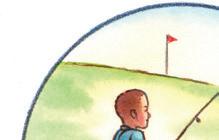
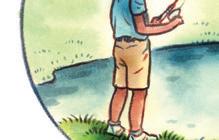



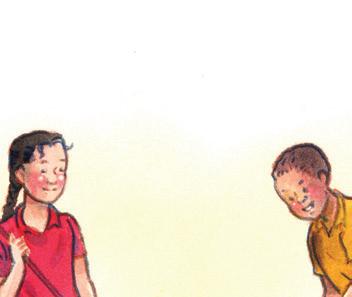
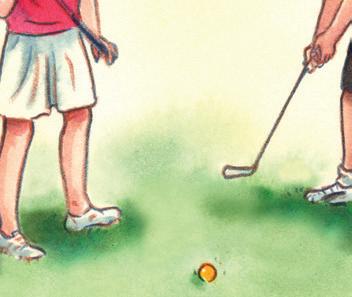
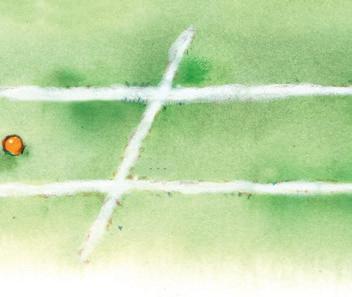
BY MADELINE MACCLURG
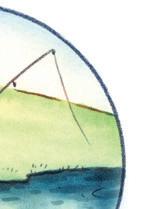


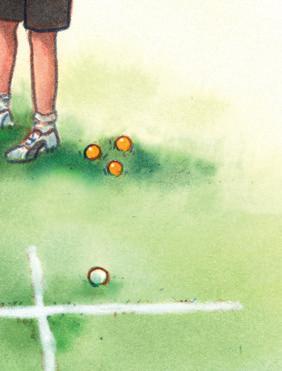
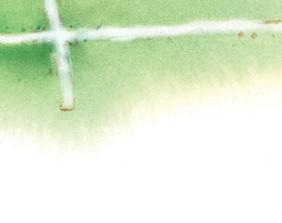
It can be intimidating to take your child out to the range or the course. What if you’re too tough on them? What if you distract or slow down other groups? What if your child inherits your incurable slice?
Remember that his or her attention span is shorter. A session as short as 20 minutes might be perfect. How to spend that time? Brian Burgwyn, a U.S. Kids Master Kids Coach, says gamify our practice. “Sometimes, the best way to practice is where they don’t realise that they’re practicing.”
A classic game to play with your kid on the practice green is tic-tac-toe because it teaches aim, speed control and
strategy. All you need is something to mark the boxes with, like tees, string or chalk, and you’re in business. Depending on skill level, hit putts from five or ten feet from “the board” and see who can get tic-tac-toe first. You can also incorporate a rule where players can knock their opponents out of their boxes. This helps players develop their aim, distance control and strategic thinking. As your child’s skills improve, build up to longer-distance putts. You can also use this game with chipping.
“Bowling” is another fun game for the putting green. Anthony Rodriguez, Senior Program Director at the First Tee of Metropolitan New York, loves this


game for juniors because it teaches kids how to account for stroke and distance while also developing speed control. To set this one up, place ten tees upside down in a triangular bowling-pin formation and spaced so a golf ball can’t quite fit between them. Drop two balls about eight feet away and try to knock down as many pins as possible. Score this like you would a traditional game of bowling.
You don’t always have to set up elaborate drills to keep your kid engaged. Burgwyn says making golf fun can be as simple as challenging your kid to hit a shot high, or left, or wherever! Sometimes you don’t even need golf balls. Dona Lerner, a U.S. Kids Master Kids Coach, says that hitting pine cones in the back yard is a great way to simulate the sensation of swinging through something. She also endorses enlivening bunker practice by swapping out golf balls for giant marshmallows. On really hot days, Burgwyn switches out regular range balls for water balloons.
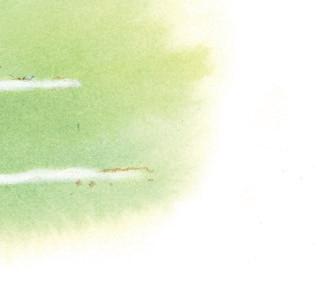
Like many golf parents, you might be wondering if there’s a “right time” to take your kid to the course. Many junior golf coaches we spoke with agree: anytime! If your goal is to grow a child’s love of the game, he or she must first feel comfortable on the course.

Instead of droning on about technique or strategy, make it fast-paced by having your child partner with you in a parent-child scramble format. You can start around the green to boost the child’s confidence and work back as the child improves. Not only will the kids learn valuable playing skills, a scramble is also a great opportunity to collaborate with them on the course.
When your junior is ready to play on his or her own, scale the course to his or her skill level. Start at about 70 yards away from the flag with minimal to no obstructions or hazards. The first time out, call a 70-yard hole a par 5. Once the child can consistently make par, change it to a par 4 and then a par 3. As your junior’s game progresses, use the Longleaf Tee System as a guide to figure out how long each hole should be for your child. The Longleaf Tee System is a joint initiative from the American Society of Golf Course Architects and the U.S. Kids Golf Foundation that’s designed to create a fun and fair course for every player. How does it work? Essentially, you allow driving distance to decide the yardages any golfer plays. For example, a child who carries the ball with their drive 100 yards would play par 4s between 146 yards and 214 yards. This allows the child the opportunity to use every club in the bag and develop a well-rounded golf game. If you want to get granular, you can refer to charts on the Longleaf website to set specific tees on your home course.
Scaling the course doesn’t only apply to yardages but also expectations. Because golf is often a recurring-cost sport, Lerner explains that many parents feel like they need to see their child improving at a certain pace to justify the money they’re spending.
“You can’t measure the success of your investment every time your kid touches a golf club,” Lerner reminds.
Minimising expectations will reduce the pressure kids feel on the course and make their experience more enjoyable. That’s all you want for your child—to love golf, too.
Jonathan Wall, Golf Digest Managing Editor (Equipment)
An old set collecting dust in the garage feels like a perfect opportunity to retrofit and save a few bucks. As a father of three, I’ll cop to considering a similar strategy for my kiddos. Cut-down clubs worked for Jack Nicklaus! But the consensus in the golf equipment world is never. It can make a shaft so sti it’s virtually unplayable and a kid miserable. You don’t need to spend much.
Marty Jertson, Ping’s vice president of fitting and performance, suggests starting with a handful of junior-specific clubs—driver, fairway wood, 7-iron, wedge, putter should do—and letting creativity lead the way. “There’s a lot of skill development that happens if you give them a limited set,” Jertson says. “Let them learn how to manipulate the face. Make them earn more clubs.” Also, woods should have at least 15 degrees of loft. “Getting the ball into the air is magic,” says Dan Van Horn, U.S. Kids Golf’s founder. “To help them achieve that, use a tee often and make sure they have proper clubs.”
Brittany Lincicome, eight-time LPGA Tour winner
Even though you love playing 18 holes, delay taking your kids out for a full round. My dad took my brothers and me to the range to teach us how to hold the club and swing it. The main purpose of those outings was to spend time together. Once we were making contact, Dad took us to a par-3 course under the lights. The longest hole was 80-some yards. The focus was on having fun and being together and not slowing any other groups down. We spent a few years there before going to a full-sized course. I loved those nights under the lights. Now that I’m a mum, I send my daughter, Emery, to First Tee clinics because I know their focus is the same as my dad’s: Have fun and enjoy being with good people. Emery reminds me of myself the way she goes out there and just tries to hit it as far as she can. I’m going to keep doing what my dad did: Let my kids play multiple sports and have golf be a normal part of that rotation. Hopefully, it’ll be something we can enjoy together for a long time.—KL

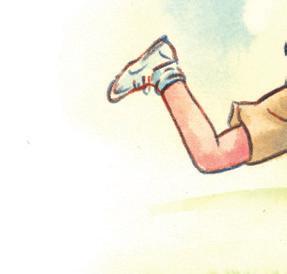
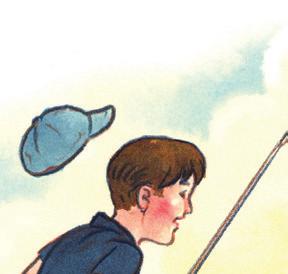





BY DREW POWELL
You’ve heard about the kid in a candy store, but what about the junior golfer in an ice cream shop? Sweden’s Ludvig Åberg says it was enjoying the frozen delight with his dad following rounds of golf that helped spark his love for the game. Fellow countrywoman and World Golf Hall of Famer Annika So-

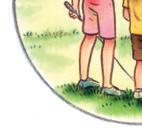

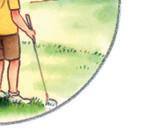
My husband, Mike, and I introduced our kids, Ava and Will, to golf when they were young, but they didn’t like it. “What a bummer,” we said to each other. My parents introduced my sister and me to golf the

renstam recalls enjoying plenty of ice cream at the golf course growing up, the memory of which today still “brings a smile to my face,” she says.
Perks to incentivise a child to practice or play can create fun associations. Sport psychologists agree, however, that not all rewards are created equal, and un-

derstanding how to properly motivate a junior golfer can be the difference between burnout and lifelong enjoyment.
Dr. Beth Brown played collegiate golf before earning her doctorate in sport psychology. She has devoted her professional career to youth development, notably at The First Tee and now as the Senior Athlete Development Specialist at the USGA. Coincidentally, when she was growing up in eastern Oklahoma, Brown’s dad owned an ice cream shop, and she recalls teams and families regularly flooding in to celebrate a win.
Brown coined this the “Dairy Queen Syndrome” because the ice cream reward was almost always contingent upon the team winning. “When those
same way they introduced us to everything: Here’s a soccer ball; go kick it if you like. Here’s a golf club; we can go to the driving range if you like. We tried a lot of things as a family until we figured out what we really loved to do. Mike and I know that our job is to introduce our kids to everything so that they can
hopefully find that thing they’re excited about when they wake up in the morning. In 2015, I was going to the Drive, Chip and Putt event at Augusta National. It was over Easter, so Mike and I decided to go as a family. Ava and Will had so many questions about what the kids were doing and how they got there. They
asked if they could do it. I said, “Yes, but these kids have practiced very much to qualify to get here, so you need practice, too.” We signed them up for the next year’s qualifying, and they practiced every day before and after school for two months. Now, Ava is a social golfer, and Will plays all the time.—KL
Dave Schnider, CEO Fujikura Golf

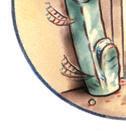


I introduced my son casually to golf by taking him on the course with me a few times, but at age five it was clear that he didn’t want to play. He was getting frustrated. I wasn’t having fun, either, so I took a step back. For four years, he didn’t touch a club. He played other sports, and I played golf with my friends. He showed interest in golf again when he was nine, so I signed him up for PGA Junior League. He kind of liked playing with the other kids but was still more competitive in other sports. Fast forward to high school and he decides he’s done with basketball and soccer—now he wants to play golf. He absolutely dove into the game. Now he’s 16 years old and is a plushandicap with plans to play college golf.—KL
a junior was swinging out of balance, for example, he would tell the child to hold the finish so that he could take a picture of the sole of the child’s shoe. When Petitpas showed the junior the photograph, this served as the external reward. “If they can get some success experiences, that develops their belief that Maybe I can do this,” Petitpas says. “Then comes the self-efficacy and then comes the addiction to golf.”
Instead of rewarding juniors only when they succeed, Brown says to also reward them for accomplishing process-based goals, like trying their best, keeping a positive attitude or being a good teammate. Equally important is to not offer these rewards everytime to tap into the power of intermittent reinforcement.
incentives are based solely on outcome, which become extrinsic motivators, they produce some short-term results in kids but do long-term damage because they lose that fun, that joy, that reason they’re playing,” Brown says.
Dr. Albert Petitpas, a former psychology professor at Springfield College and one of the nation’s leading authorities on sport-based youth development, agrees that extrinsic rewards like these are lousy motivators. “They put all the emphasis on outcomes and not the process of how you get there,” says Petitpas, who helped develop the foundation and training program of The First Tee.
Placing too much emphasis on outcome can cause juniors to tie their identity as golfers to their identity as people, says Pia Nilsson, one of Golf Digest’s Legends of Golf Instruction. “If I can’t feel good with who I am, independent of my outcomes, then it’s going to backfire,” says Nilsson, who along with Lynn Marriott founded VISION54, a popular performance school in Scottsdale.
Self-determination theory was formed in the 1980s and is a widely accepted framework for understanding human motivation. When people are self-determined, it means they are intrinsically motivated to do an activity because they are driven by enjoyment and interest. This creates long-term satisfaction. However, the theory holds that to achieve a sense of self-determination, people must feel that they are in control during the activity.
When parents offer their kids rewards
for shooting a certain score, they erode this autonomy. “If rewards are used to consistently control the young person’s behaviour, there’s no more self-determination,” Brown says. “There’s limited autonomy. Their behaviour is being controlled by the adult.”
What’s a good way to help a child find joy in golf without constantly dangling rewards over them? Petitpas says one answer is intermittent reinforcement, which is giving a reward at irregular intervals. At The First Tee, Petitpas encouraged creative games that would get juniors less focused on outcomes and more on the process. If Petitpas noticed
When utilised properly, rewards can be a powerful tool for creating a fun and communal atmosphere that will help juniors fall in love with the game. “Joy could come from having fun training sessions and then eating ice cream or a cinnamon roll together,” Nilsson says. “That could be part of making it fun, along with being with friends and being social and not always being compared because of your outcome and rankings.”
Fun: A simple goal espoused by Sorenstam, Nilsson, Petitpas, Brown and parents all over. But how do you know you’ve done it right?
“When you take the kids home, you want them to say, ‘When can we go back, Mummy?’ That’s the biggest success,” Sorenstam says.
David Leadbetter, Golf Digest Legend of Golf Instruction
Seve Ballesteros once told me how he’d keep his kids from the course when they were enjoying it. He wanted them to beg him to go to the golf course. When our daughter, Hally, didn’t want to play golf as a young child, we knew we had to let her do other things. For her to gain that love a air with the game, she needed the space to come to golf on her own terms, if she’d come to it at all. My wife was 15 when she started to play golf and went on to compete on the LPGA Tour. Hally was casually around golf just by being in our family, but she really loved horseback riding. When Hally was 12 or 13, she said she wanted to play golf. We remained calm and supported her by getting her equipment and coaching. When Hally got into it, she really got into it. She had a good college and amateur career and turned pro. Quickly, she decided to get into the media side. Now there’s no denying how much she loves the game.—KL


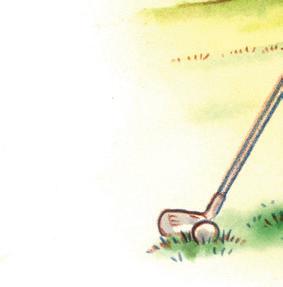
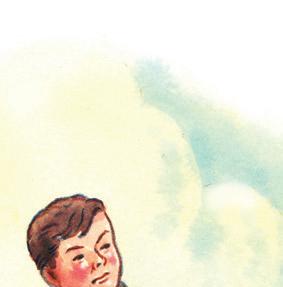
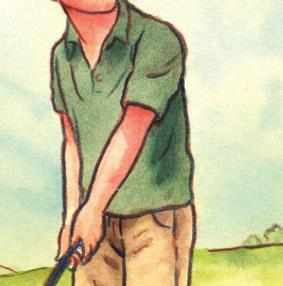
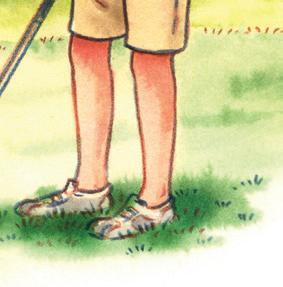
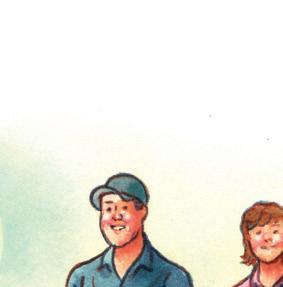

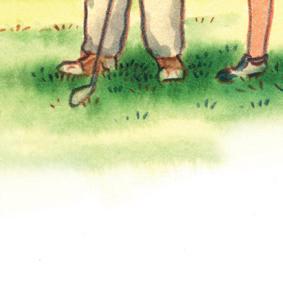
BY SAM WEINMAN
When your kid loves golf, the toughest days are when they also kind of hate it. Water balls, tears, occasional sprints to the parking lot—there’s enough trauma available in golf for a parent to wish for something simpler. The best argument
for having your kid stick it out might be how the game can help kids navigate everything else in life.
David Yeager’s best-seller, 10 to 25: The Science of Motivating Young People, isn’t specifically about golf. The Uni-



versity of Texas psychology professor’s book is a deeply researched exploration into the developing adolescent brain, how it responds to challenges and stress, and why certain messages resonate with kids more than others. For a book that isn’t about golf, a lot of it feels like it’s about golf.
“I am never playing again!” Among Yeager’s central tenets is that with kids, parents should adapt a “mentor mindset,” which falls between two common extremes. Consider a familiar scenario, an 11-year-old unraveling in an early golf competition. The parent who only disciplines a child is setting too high a standard with
IT DOESN’T HAVE TO BE EXPENSIVE
Ben Gri n, PGA Tour player
Golf has a reputation for being expensive, but you can raise a kid who loves golf on a budget. My parents introduced me to golf at our country club, and I was one of those kids who loved it right away. Golf was a fun way to spend time with my dad, and I was pretty good at it. When we left the club due to financial reasons when I was 12, my parents kept my love of the game alive by figuring out how to get me access to golf without having to overspend. There was a Golf Galaxy in a shopping centre my mum would go to, so she’d drop me o there, and I’d hit balls and putt while she shopped. They found a public golf course with a chipping and putting green and would drop me o on their way to work in the summer and pick me up on the way home. They were creative and made sure I was surrounded by good people. Golf can be very a ordable if you get a little creative in your approach.—KL
Ryan Palmer, four-time PGA Tour winner
Too many parents have too much riding on their kids’ golf. They base their social lives around it and get satisfaction out of their kids playing well. My dad was really only concerned with my behaviour. He’d unceremoniously take me o a golf course if I let my temper get the best of me. Our son, Mason, wasn’t into golf as a kid, so we never pushed. When we did play, the only expectation was he follow proper etiquette and be respectful. When he was 13, he said he was done with hockey and wanted to get back into golf. It was a bit of a shock. Of course, I was happy to help, but I can’t make him good. I can’t make him practice. He knows that part is on him. I help him when he asks, but he has his own coaches he works with. I’m here to encourage and teach him how to act, like my dad did with me.—KL





insufficient support—what Yeager calls an enforcer mindset. A parent who wants to swoop in and save the child, or worse, decides not to let them compete in the first place, is guilty of a protector mindset—all support and no standard.
The mentor mindset is built around an equal measure of high support and high standards, which means giving young golfers a chance to develop skills while reinforcing their ability to cope with what the game can throw at them. Yeager’s refrain is that kids seek “status” from adults more than we realise.
“Choosing to be in this important competitive environment is impressive. It’s a high-status thing,” Yeager says of the message he advocates sending kids. “If you’re going to compete where it’s uncertain how you’ll do, that takes courage.”
“I’m sooo nervous”
Yeager forces parents to reconsider the assumption that stress is only detrimental. As Yeager notes, stress—from a racing heart to sweaty palms—is simply the body activating for performance. The tricky part is how we perceive it.
Yeager’s research elaborates on the difference between a “challenge-type stress response” and a “threat-type stress response.” When a golfer has butterflies on the first tee, the “challengetype stress response” is to accept those nerves as a natural sensation before playing, and the body responds favourably. The “threat-type stress response” is when we believe something is wrong,
and the body starts to panic even more. One of the worst things a parent can do is encourage kids not to be nervous, which is telling them to suppress an emotion they can’t control.
“For the kid, the implication is, ‘Well, I am stressed, so that must mean I’m not talented,’ or ‘I am stressed; therefore I didn’t prepare,” Yeager writes.
“But I don’t want to hit balls!”
Parents and children can often be at odds around “It’s-good-for-you” tasks like homework or cleaning a room. With golf, this argument can often be about practice.
One misconception is that a truly dedicated golfer never needs to be coaxed because motivation always
comes from within. Yeager says that’s not realistic. Golf is hard, and practice can be tedious. Rather than expecting a child to want to pound balls on the range, a mentor mindset helps the player see why it could help and appeals to their sense of reward.
“The message the parent is providing can be, ‘ It’s high-status for you to put in the preparation that other people were going to shortcut or half job,’” Yeager says. “For you to be the kind of person who’s chosen to push yourself now and get better, when other people wouldn’t, ties into status and respect.”
“Stop telling me what to do!”
Yeager’s kids are more into baseball, where he fights the tendency to tell his son what to do at every step of his pitching motion. However well-intentioned, a parent’s desire to overload their kid with knowledge usually comes at the expense of the athlete developing his or her own instincts. When a young player is pulling every tee shot left, a knowledgeable parent might note it’s because their kid is rising out of the backswing and coming over the top. Rather than tell the player the solution outright, Yeager advises asking players enough questions so they can diagnose and fix the problem themselves.“You want to practice in an environment where you’re coaching them, but you’re coaching in a way where they know how to critique their own mechanics and form,” Yeager says. “The logic is that players need to play the game in their heads, but if, as a parent, you’re telling the kid how to play the game, then you are owning the mental effort.”
Erika Larkin, Golf Digest 50 Best Teacher
The advice I give all golf parents is something that worked for me when I learned how to play with my family on a pitch and putt: Leave while everyone is having fun. If you wait until your child gets tired, the attitude toward golf sours. If your child is smiling when he or she leaves the golf course, that child will want to come back. You can also create this positive association by letting golf be the reward for something the child has earned. In the same way that you’d reward your child for getting through a doctor’s appointment or celebrating something at school with a new toy or a special treat, reward the child with golf. That way, golf is in the same category as treats: It’s a desirable, special thing.—KL


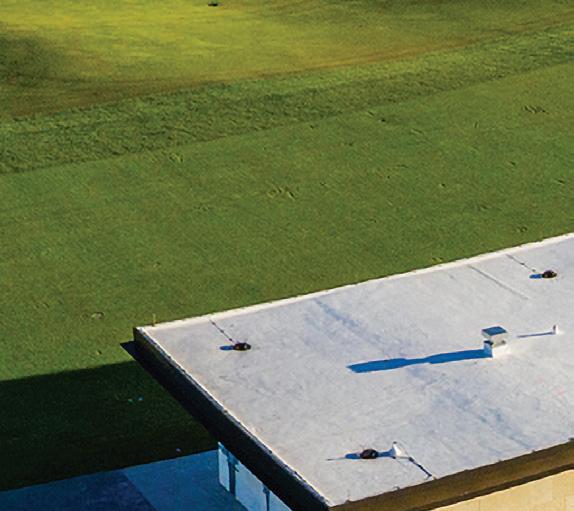
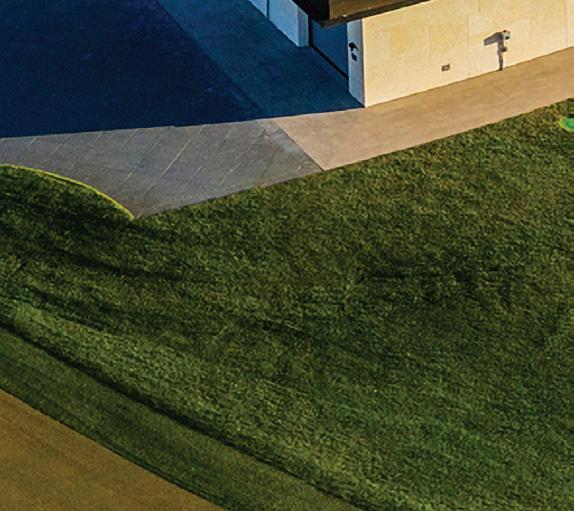
A NEW WAVE OF TRAINING FACILITIES UNDERSCORES HOW WE’VE BEEN PRACTICING ALL WRONG
BY SAM WEINMAN
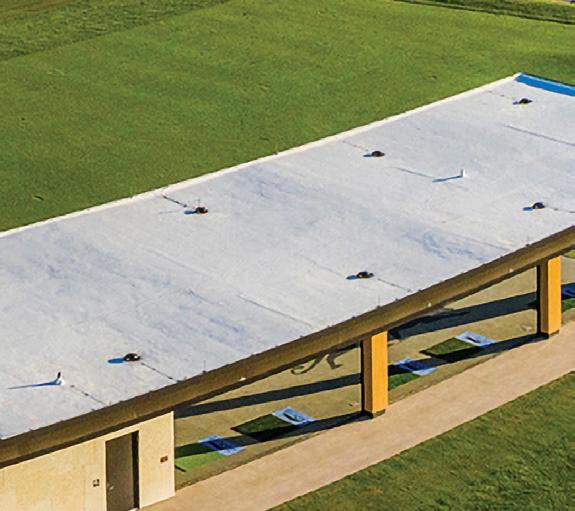
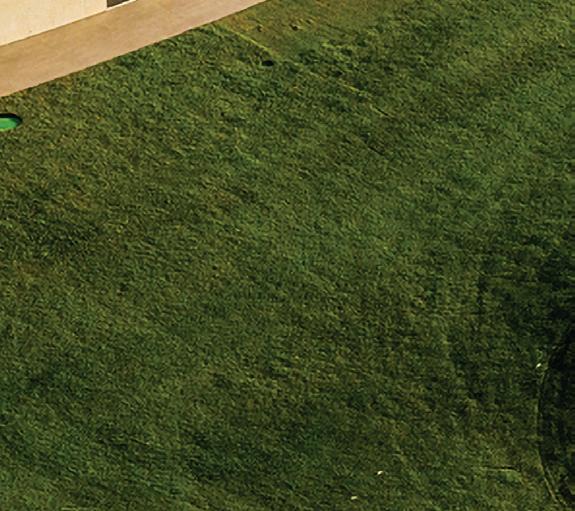

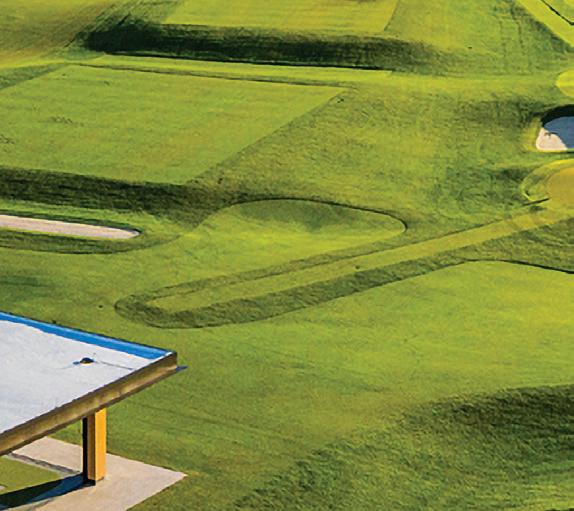


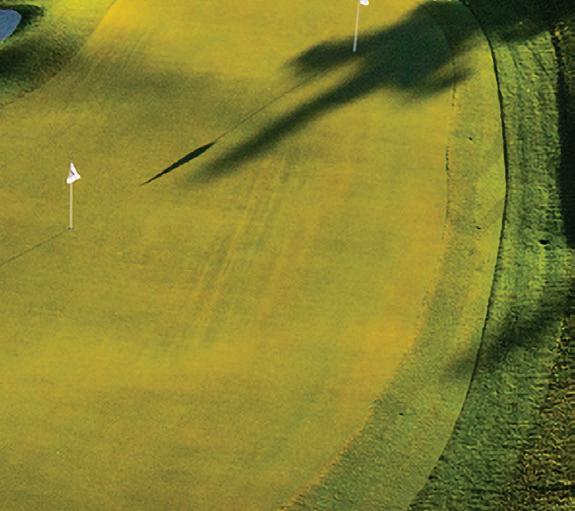

PRACTICE PARADISE
more than just a


he most common affliction in golf is not the slice but the driving range swing that has mysteriously vanished. For many players the typical practice session involves a bucket of balls, a series of swings and the occasional sense that a problem has been solved. If it rarely works out, it’s because this way of practicing has little to do with golf.
The moment this idea really sunk in I was hitting wedges at The Grove XXIII, and not particularly well. The Grove is Michael Jordan’s South Florida golf oasis. It has plush leather chairs in the clubhouse and drinks and snacks delivered on the course by drone. Most of the experience is built around maximum comfort, but the practice area is designed around the opposite.
On the Grove range, the golf coach Darren May paced me through a drill he gives some of the best players in the world. There was a green 100 yards away, where May had planted four wooden stakes around the edge. The arrangement was not random. May uses strokes/gained data to create an appropriate-sized target for a player’s skill level, which isn’t to say the drill for a 10-handicap like me was meant to be easy. All the target greens are elevated with an assortment of shelves, and the wind was blowing. After I missed the first target from 100 yards, May moved me back another six yards, and I missed that one. Then May moved me again. That I missed most of my targets and felt flustered throughout was precisely the point. In that sense, it felt like my usual day of golf.
May’s sessions differ from typical golf lessons in that they are not meant to be back-slapping confidence builders—or at least not in the moment. Along with Jordan and other Grove members, May works with major champions like Keegan Bradley and Justin Thomas as well as tour-aspirant college golfers. All entrust May to structure practice sessions largely built around failure. The more strain May can create at the
A sequence of greens with bells as bullseyes tests your wedge control at Papago.
Grove, the better because they recognise tournament golf is even tougher. (No matter how impressive Grove’s setup, it, too, is subject to improvement. The club is renovating both the course and practice facilities.)
If the facility stands out because of the exclusive address and the golfers who show up there, it also represents an overall shifting approach to golf practice. Thanks to launch monitors, there has never been more information available about how we swing the golf club and the way the ball reacts, but this feedback rarely accounts for golfers’ tendencies in specific situations. It’s one thing to groove a pitching wedge on an open range, but what happens to the swing when you’re staring at a narrow green surrounded by bunkers or with a one-shot lead on the 18th tee? It’s only when training under what May calls “mental load” that golfers are provided an accurate sense of both a problem and a solution.
“People don’t want to fail on the golf course, but that’s not the right way to coach them because it’s going to happen,” May says. “I’m desensitising them to it, so they have a better sense of what they can handle and what they can’t.”
As much as May believes golfers should strive for better mechanics, he believes limiting practice to the controlled setting of a driving range or a simulator misses the point. Unless your usual Sunday game involves hitting 40 consecutive 8-irons off a perfect lie, you need training conditions that can bridge the gap between low-stakes range sessions and pencilin-your-pocket competitive rounds.
Other sports figured this out long ago. College football teams will pump crowd noise during practice to prepare players for the chaos of Saturday. In baseball, hitters transition from batting cages to live pitching then to hitting with runners on base. But it’s taken longer in golf. The old stories of Earl Woods jangling his keys during Tiger Woods’ backswing represented an extreme form of situational practice, the father conditioning his son for inevitable distractions. Decades later, it speaks to a philosophy that is gaining more widespread traction, reflected in elaborate practice areas like the Grove’s and other high-end clubs that are meant to sharpen players’ focus under different forms of duress.
The path to lower scores isn’t making more 10-footers but avoiding three-putts through better speed control. This drill tests your lag control under pressure.
A practice green, three tees, two golf balls, and a putter.
1. Find a relatively flat section of green. Place one tee at your feet, then pace off 10 steps to place down your second tee. Pace off another five steps to place the third tee.
2. Standing at the first tee, putt your first ball to at least the second tee distance, finishing as close to it as possible.
3. Each subsequent putt must finish past the ball that preceded it, but cannot travel further than the third tee.
4. Following this pattern, putt as many balls as possible before putting a ball past the third tee.
Two-time PGA Tour winner Nick Dunlap took this drill and eventually scored 9.
Down the road, Apogee Golf Club is nearing completion of its 60-acre facility with a 360-degree range featuring elevated tee boxes and target greens shrouded by bunkers, plus a separate short-game area with an AimPoint practice green designed by tour putting coach Stephen Sweeney. Augusta National’s 18-acre tournament practice facility has devoted careful thought to every element, including practice greens and bunkers that are precise facsimiles of the actual course. A similar feature is available at New Jersey’s Metedeconk National, with replica fairway routings allowing players to practice different shot shapes. Leading Division I college golf programs like Arizona State and the University of Illinois have invested millions in creating elaborate training areas meant to entice recruits and sharpen current players for tournament play.
It’s not just where golfers are practicing. More important is what they’re choosing to emphasise. The reason May works with several players who have separate swing coaches is because they seek his input in structuring practices that are inordinately demanding. Similarly, Nico Darras and Kevin Moore developed their company, Golf Blueprint, to devise “reactionary practice” routines of assorted game-like challenges for tour players and other competitive golfers.
“It’s a lot about keeping your finger to the flame as long as you can and just kind of becoming numb to it,” says Nico Darras, co-founder of Golf Blueprint. “We will create stressors so that when that moment happens, you’ve now done it enough.”
Recognising this type of competitive practice doesn’t always require a sophisticated facility, Darras and Golf Blueprint have assisted Golf Digest with the development of a series of “Stress Tests” that are practice games designed to approximate round-like scenarios—for instance, a putting game that teaches speed control under pressure or an up-and-down game that tests recoveries from short-sided misses. The options can vary depending on the setting, but they all trigger more thought than hitting a ball into an open field or chipping aimlessly.
“I go to the driving range all the time and just sit and watch what golfers do,” says Darras, a former college baseball
The measure of a good short game isn’t just executing chips and pitches; it’s also overcoming di cult lies. This drill tests your ability to save par from challenging positions.
YOU’LL NEED
A green with a tucked pin, a wedge, a putter, three golf balls.
1. Identify a spot on a shortgame area hole or golf hole with limited space to chip to.
2. Identify three di erent lies – one good, one challenging and one inordinately di cult.
3. Drop a golf ball in each lie and play the hole out from there.
4. Tabulate your score over 9 balls. Score to beat: A tour pro with a dialed short game might get up-and-down twothirds of the time, producing a score of 21.
SCORE TO BEAT:
Middle-handicappers should try to break 30.
player who turned his attention to golf after suffering a career-ending injury. “They have no targets, no alignment aids. It’s just bad, bad, bad, bad. The goal is to give them some structure. That’s the lowest-hanging fruit.”
The lazy habits ingrained at the typical driving range are often traced to the misconception that dropping a bucket of balls at your feet and swinging away can only help. In fact, Golf Digest Best Young Teacher Will Robins says the reason golfers of the 1940s and 1950s used their practice time more constructively is because they had no other choice.
“Back then a Trackman was a shag bag,” says Robins, who is based in Folsom, California. “You went out to a field, and you put your umbrella out there, and you hit at that target, and you learned your distances to your umbrella and your towel. Everything had a purpose because you’re like, ‘I have to go and pick this thing up. I have to go and find it afterwards.’ We’ve totally taken that away with the driving range. There’s just absolutely no accountability there.”
May has plenty of gadgets at his disposal at The Grove. But his best tool in measuring accountability is the four wooden stakes. After I complete the wedge-control drill, May calls over the Chinese tour pro Yuxin Lin to demonstrate his version. Lin is 24, has twice played in the Masters after wins in the Asian-Pacific Amateur Championship, and now plays the Korn Ferry Tour. May tightens the stakes to limit Lin’s target to a small shelf in the back left quadrant of the green; this dispersion is based on the average of the best wedge player in golf. Lin lands his first shot within the stakes, but it trundles off. The next shot hits and spins back. Through every missed shot, Lin appears unfased. Eventually, Lin sticks a ball to pin high, two feet from the flag.
“When you first start teaching and that client’s failing, you want to help them straight away,” May says. “We’re used to getting in there and stopping the bleeding, but we’re trying to help them be a little more creative and imaginative without being so conscious of their mechanics.”
It is not a coincidence that the backdrop for this exercise is a golf club founded by Michael Jordan. The Grove’s


ornate touches underscore Jordan’s status as a living icon, but the practice area reflects how he became one. As a basketball player, Jordan emphasised “self-discovery,” which was only possible through resistance. He became a better jump shooter when the lanes to the basket started to close, and he became a better passer once defenders began to challenge his shot. This emphasis on self-discovery is how May designs his training sessions. “Confidence in Michael Jordan’s view is not hoping you can do something. It’s knowing you can do something,” May says. “That doesn’t happen if you don’t train without a sufficient level of discomfort.”
May’s connection to Jordan can be traced to another basketball legend. In the early 2000s, he was working at Atlantic Golf Club in Bridgehampton, N.Y., and giving lessons to Larry Brown, the Hall of Fame coach who won both an NCAA title with Kansas and an NBA crown with the Detroit Pistons. During one lesson, the basketball coach mentioned he viewed himself as an “execution coach.” He sought not



Nearly any shot can be simulated at the 360-degree, 55-acre facility at Apogee.
just to teach players skills, but how to apply them in specific moments. May realised this wasn’t something he thought about enough.
“At that point, I was just giving people lessons, and they would just go and practice on their own, but we were not training under any sort of load,” May says. “I was an instructor, but I wasn’t responsible for someone’s execution. I was only helping them with how they hit the ball.”
Two decades later, whenever May sees Brown, he reminds the coach of his influence on his career because eventually May migrated to the Bear’s Club in South Florida, where Jordan was a member, and the two men recognised a shared philosophy around the relationship between failure and improvement.
“I also talked to Michael about how he viewed coaching.” May says. “We had the same ideas about how if you’re not failing, you’re not learning, and that you
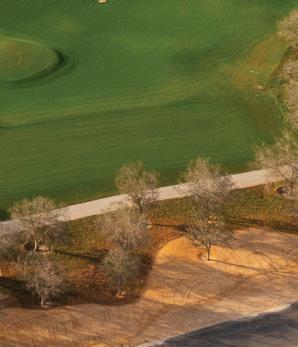
shouldn’t search for comfort … Then when he wanted to start his own place, and he knew that I was involved with coaching a certain way, that led him to ask me whether I had some insight into how to design a practice facility.”
The Grove facility attempts to modernise some of the practice principles used with a shag bag and an umbrella, giving golfers insight into why certain shots work and others don’t in an environment that more closely resembles real golf courses. The design draws inspiration from a graphic May uses to reflect ideal training conditions, with performance on one axis and difficulty on another. Where the two converge is what May calls “the learning sweet spot.” Suppose a drill is to sink a series of two-foot putts. The task is so easy, a golfer’s performance would be high, but he or she wouldn’t learn anything. Conversely, if a drill asked golfers to hit a small target from 250 yards away, golfers might disengage because they don’t believe they can do it. The sweet spot is when players are presented with a challenge that is just difficult enough that

they understand why, both when they fail and when they succeed.
May’s principles have gained enough traction that he has been contracted to help design other facilities, including a new one at TPC Sawgrass. He’s also developing a game-improvement platform for Dick’s Sporting Goods and Golf Galaxy that will create an in-store learning environment that are simulator versions of the outdoor facilities he’s designed. If the program succeeds, he believes more golfers will have the chance to adapt a military approach to training, with rigorous preparation translating to better performance.
“If you talk to people in special forces, they’re trying to make that training as close to the actual event as possible,” May says. “They’re adamant that under pressure, you only fall to the level of training.”
Of course, the idea isn’t to make a typical short-game session as miserable as boot camp. A common misconception when talking about “stressful practice” is that stress can only be unpleasant.
“When people say stress, they often mean distress,” says Dr. Jeremy Jamieson, who oversees the Social Stress Lab at the University of Rochester. “People rarely use the word stress in a way that’s positive. That’s just the way our culture works. Athletes are one of the few groups that get it. They understand, ‘Oh, yeah, I need to be on and activated to do anything well.’”
By Jamieson’s definition, stress is a signal to the body to pay closer attention, which in competition, is something golfers not only tolerate but need. Most tournament-tested players understand this, and the most perceptive recognise how that stress manifests in their golf swings, like how a sand wedge can travel 10 yards more when they’re teeming with adrenaline.
At Papago Golf Course outside Phoenix, Arizona State’s 22,000-squarefoot practice facility features 21 target greens, including a series of eight cascading targets ranging from 30 to 145 yards, with bells in the middle that ring on perfect strikes, though around the chipping greens, head coach Matt Thurmond relies on just a piece of chalk to outline the delineation between success and failure.
“It creates just a little bit of stress and makes you accountable,” Thurmond says. “You either got it in or you didn’t.”
The goal is not to just tax his players. Thurmond recognises practices that are defined only by difficulty have diminishing returns.
“We really believe that having fun practicing is vital,” he says, “because if you enjoy what you do, you’re going to do it more, and practicing golf needs a lot of volume. We try to create an environment where they just like having a club in their hands. Most golfers are pretty sadistic. If you give an elite golfer a shot that they’re going to maybe succeed two times out of 10, they actually kind of like it.”
The last part might be most important because a practice facility is only as valuable as a golfer’s motivation to use it. A good facility might help stimulate the type of focus other golfers can manufacture on their own. As Thurmond notes, a golfer doesn’t make it to Arizona State without already knowing how to practice effectively, yet some golfers enjoy solving the puzzle more than others.
Former tour pro Tripp Isenhour shares a story of when he was hitting balls next to Tiger Woods two decades
Great iron-play is about missing in the right spot as much as it is knocking it close. This drill develops an understanding of smart, aggressive approaches versus what is careless.
A driving range or a golf hole with target flags, a midor short-iron, 10 golf balls.
1. From an approachshot distance of your choice, identify a target. If the flags on your range aren’t on greens, use your imagination.
2. Hit a shot as close to the flag as possible while trying to avoid the short side of the green, meaning the side with less room between the hole and the fringe. (If a flag is on the right side of a green, a short-sided miss would be anything to the right of the flag).
3. Hit 10 shots using the following scoring system: 3 points for anything on the green and on the correct side of the flag, 0 points for anything that misses the green but on the correct side, and -5 points for any shot that lands on the short side.
ago at Torrey Pines. This was after a round in which Woods had struggled with his driver, and Isenhour recognised the superstar was working through an assortment of curious shots with his irons—draws and fades way up in the air, straight bullets barely off the ground. When Isenhour asked why, Woods said his driver was problematic enough he needed to practice the recovery shots that follow wayward drives.
“That’s the reason why I’m a freaking announcer now and not playing the Champions Tour,” Isenhour says. “When that happened to me, my thought was, ‘Damn it, I gotta fix my swing.’”
Woods could get wrapped up in swing mechanics like any other golfer, but he understood better than most the need to adapt to specific situations and to work through the challenge on his own.
Which brings up another essential lesson in effective practice: The best sessions aren’t the kind with someone hovering over a golfer’s shoulder.
When Will Robins describes his facility adjacent to a public course in Folsom, California, he knows it will never be confused with the Grove. The bunker is one they dug themselves, there’s scarce room to chip, and the range balls are bad. “Apart from that, it’s great,” he says. He’s not entirely joking because in other ways, Robins has created an environment that trains his students for real golf with lots of drills featuring similar elements as competitive rounds. In one, players compete on the putting green in pairs. There’s a circular course, and every putt is recorded on what Robins calls a “purposeful practice card.”
“They go through all the emotions, starting off well, then getting frustrated, then rushing, and that’s when I just walk away,” Robins says. “The lesson starts because now I’m adding pressure.”
When players struggle, Robins is not inclined to inject a solution, preferring instead to pose questions that will help the player attack the problem on their own. “If you don’t know the problem, you’ll never know the solution.”
SCORE TO BEAT:
A scratch golfer should get about 20 points.
It goes back to self-discovery. Michael Jordan learned by way of opposing defenders. Robins’ students learn when they start counting putts. You don’t need the fanciest facility to practice effectively. You just need something that forces you to pay attention.





























